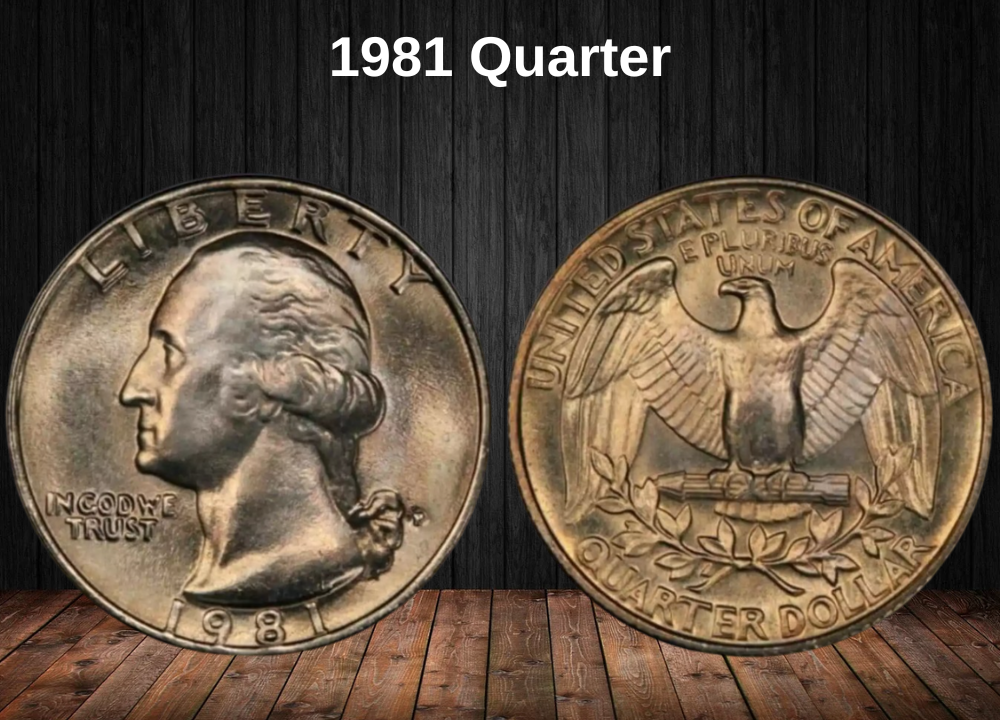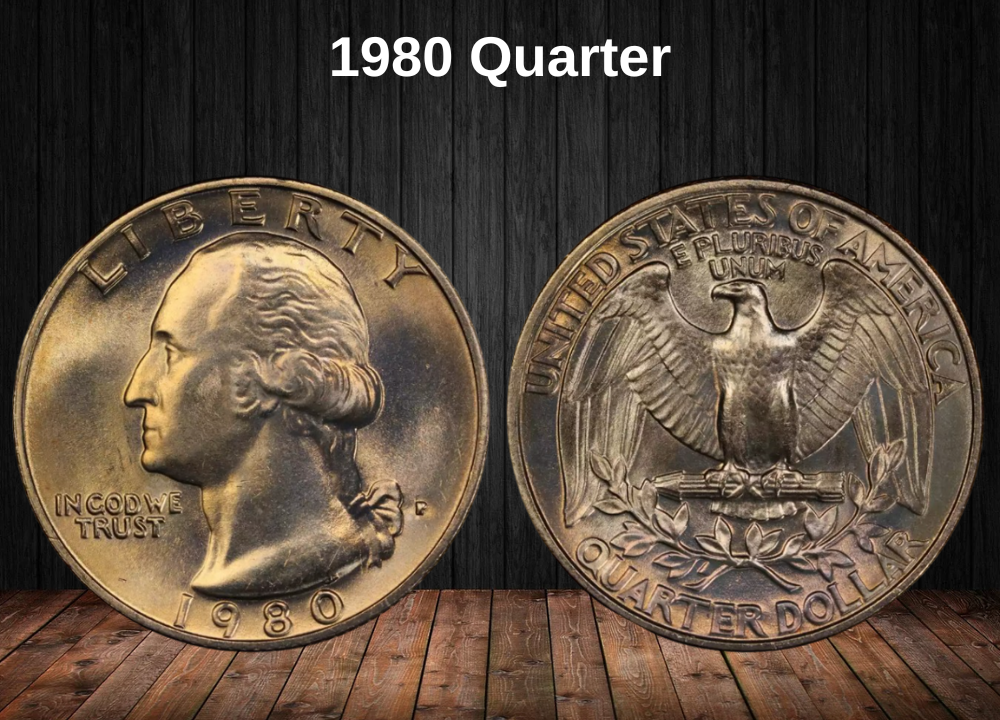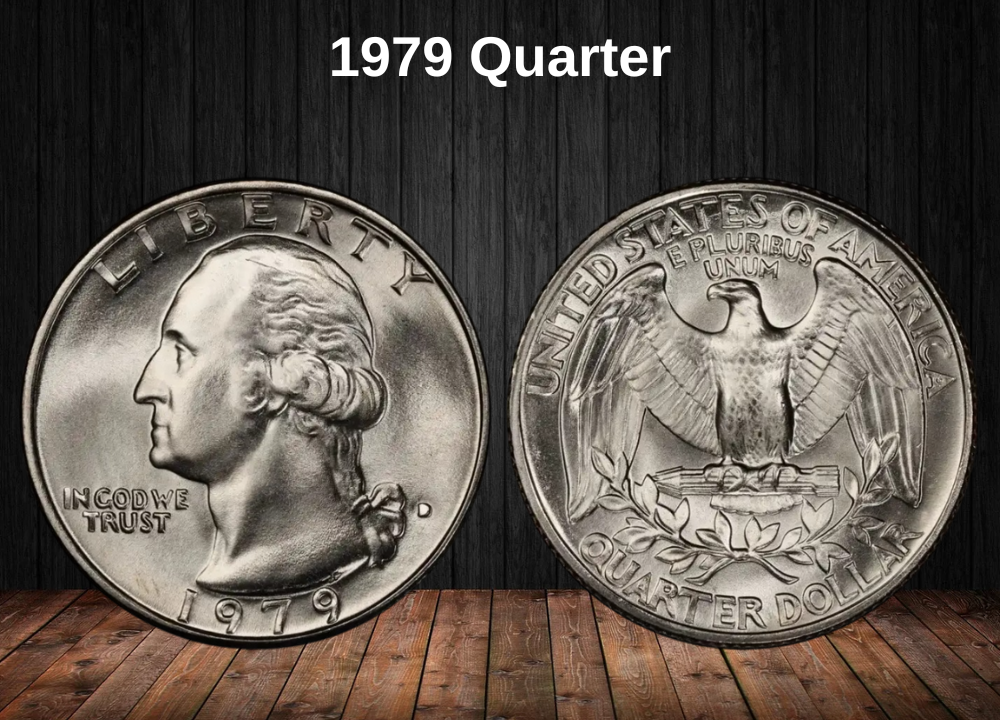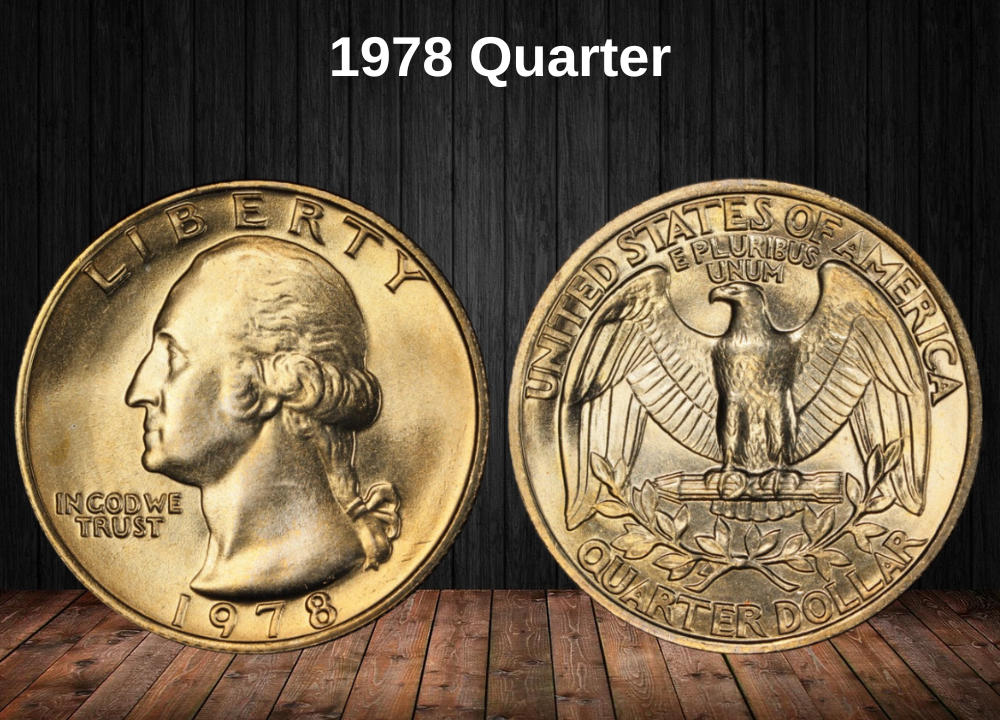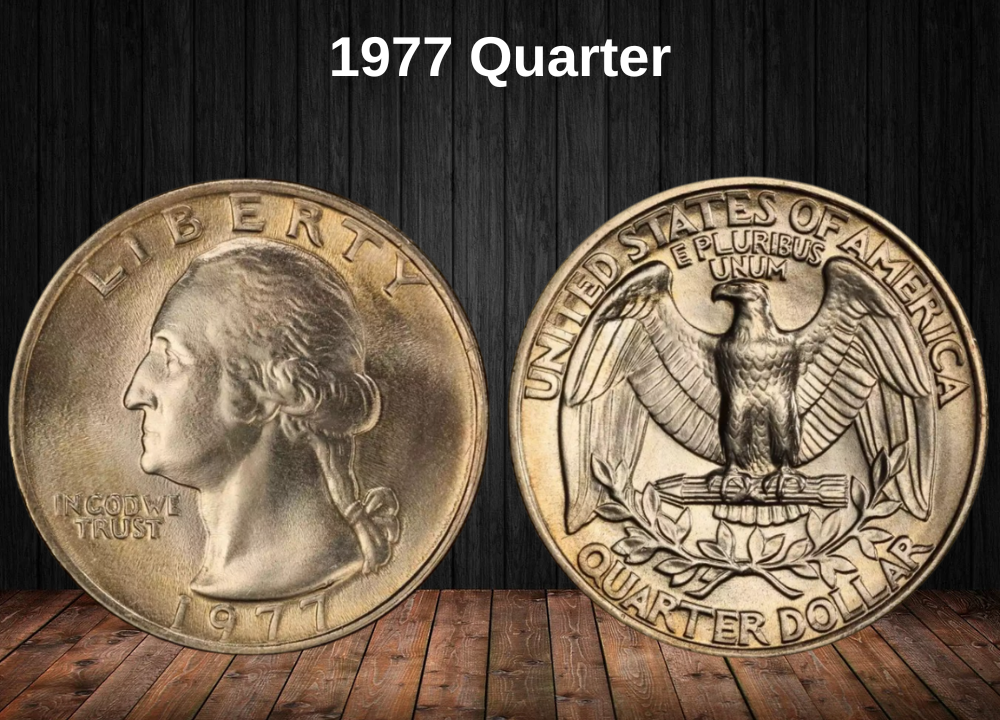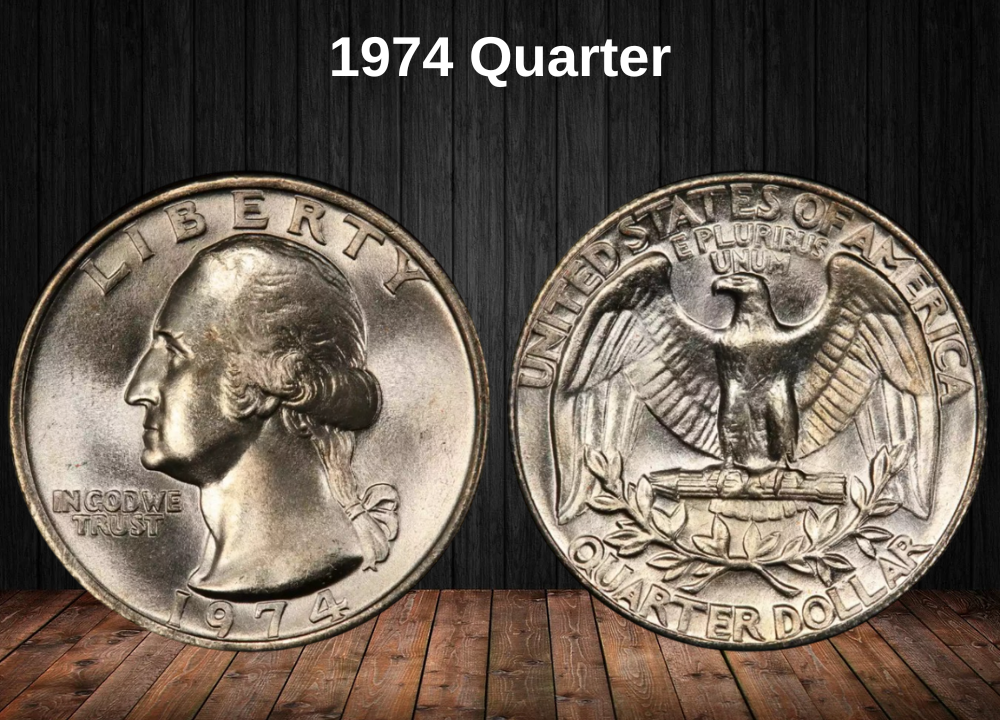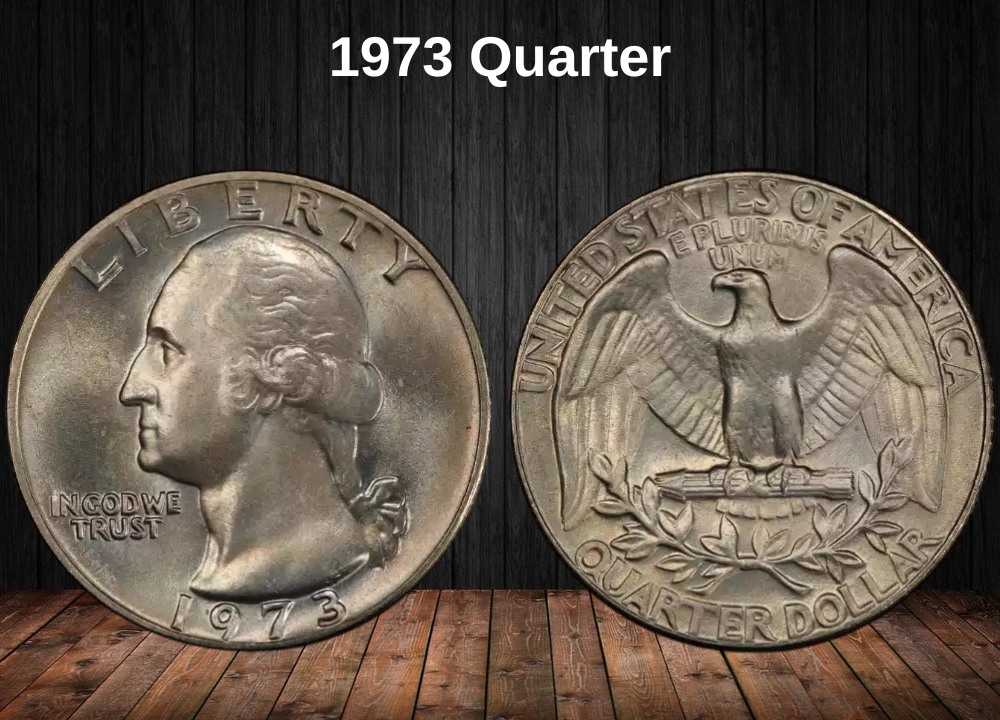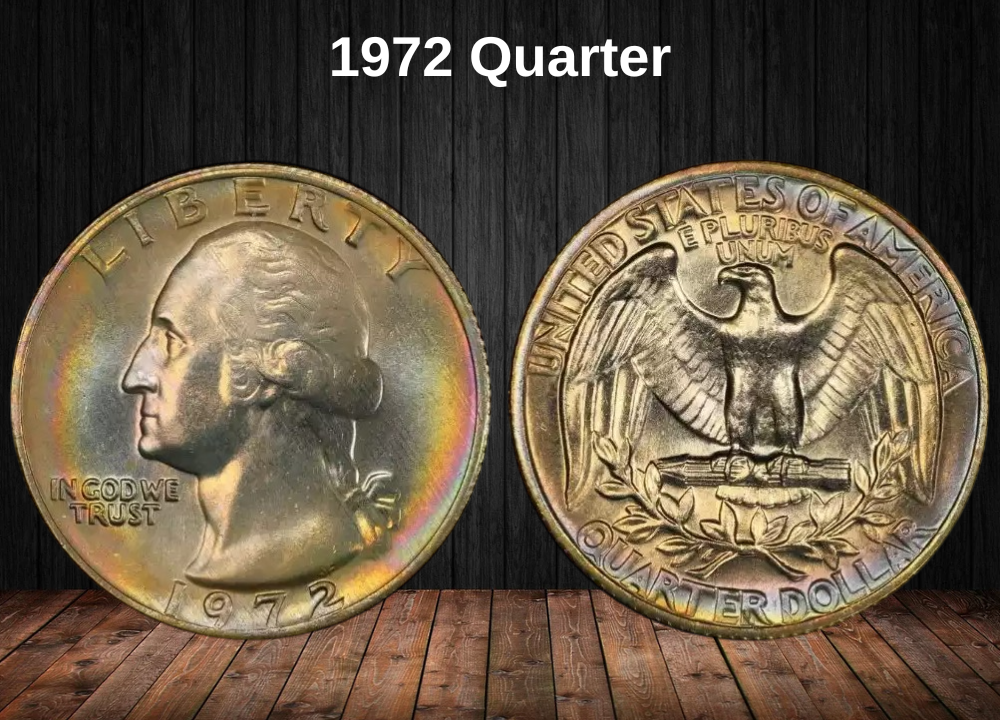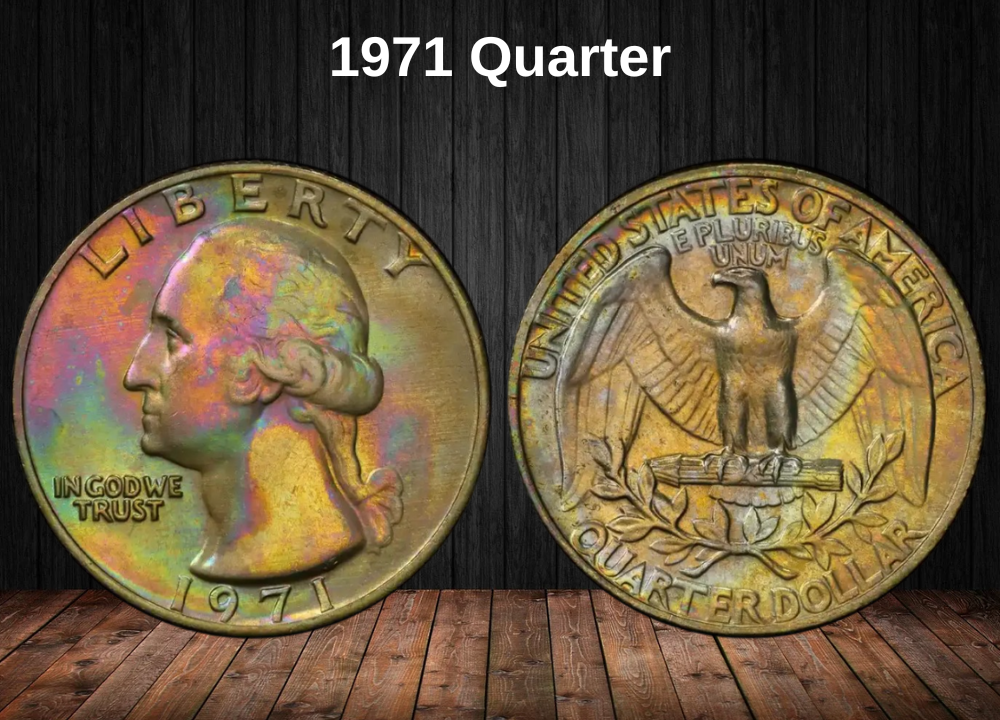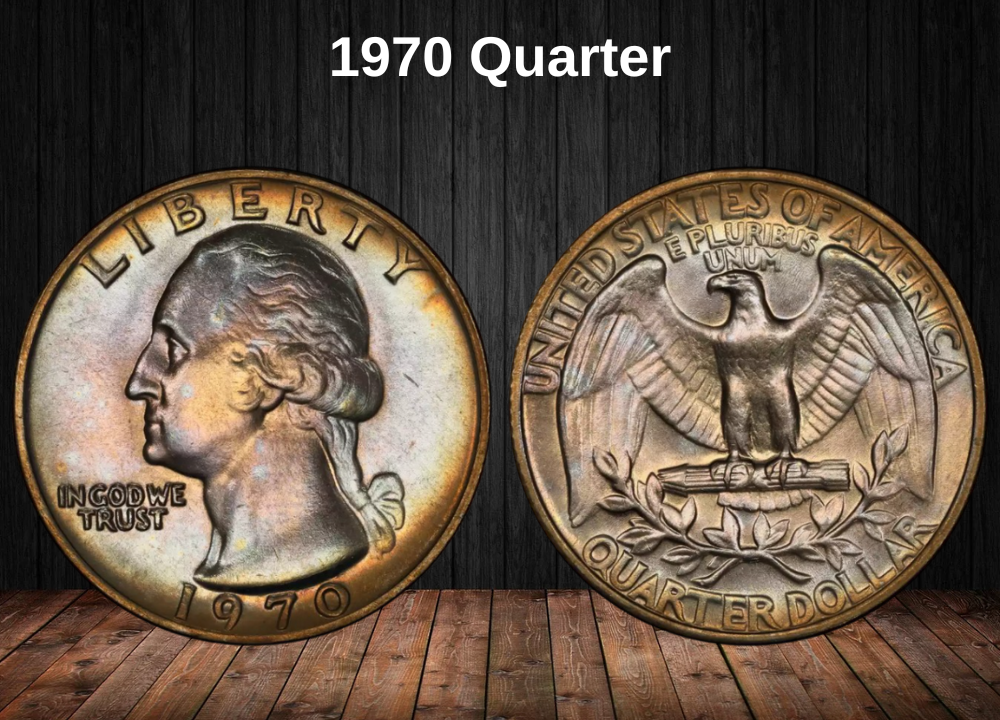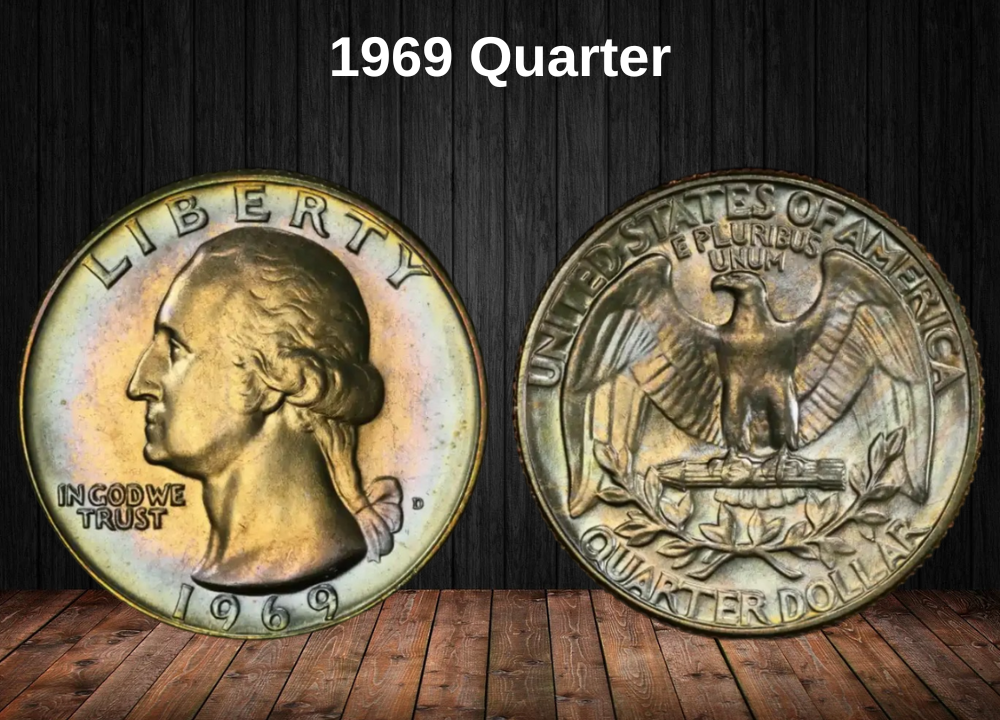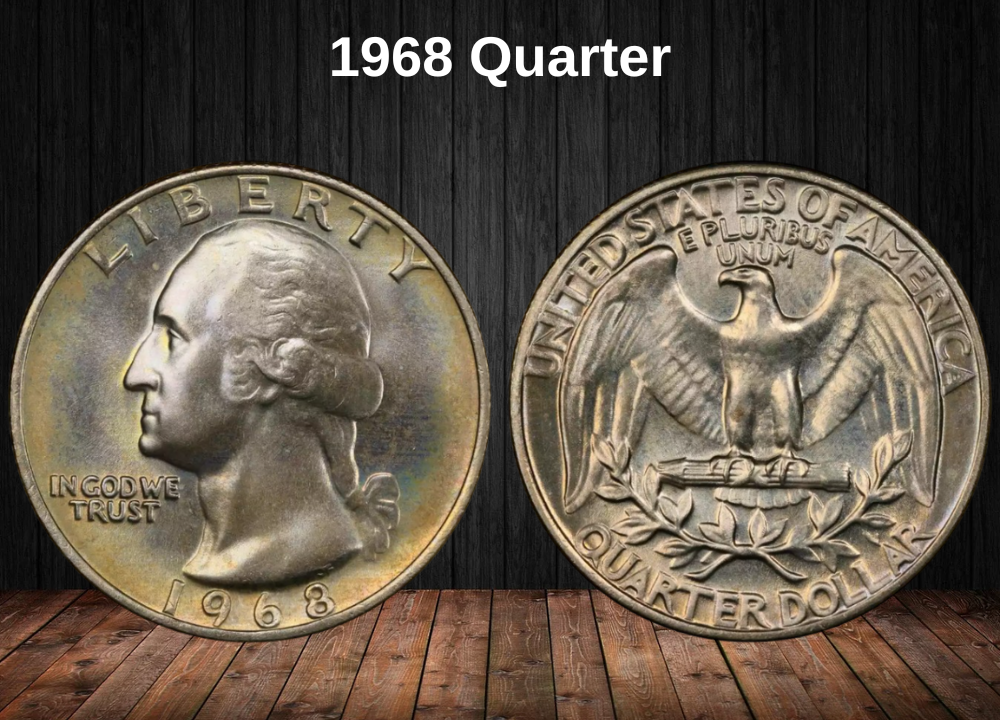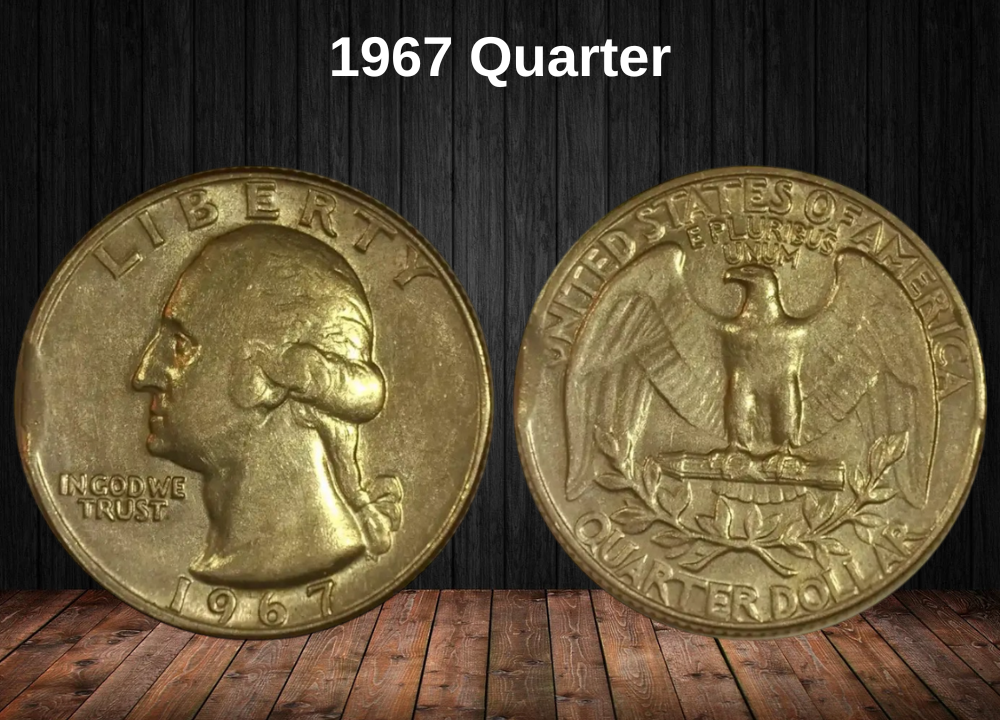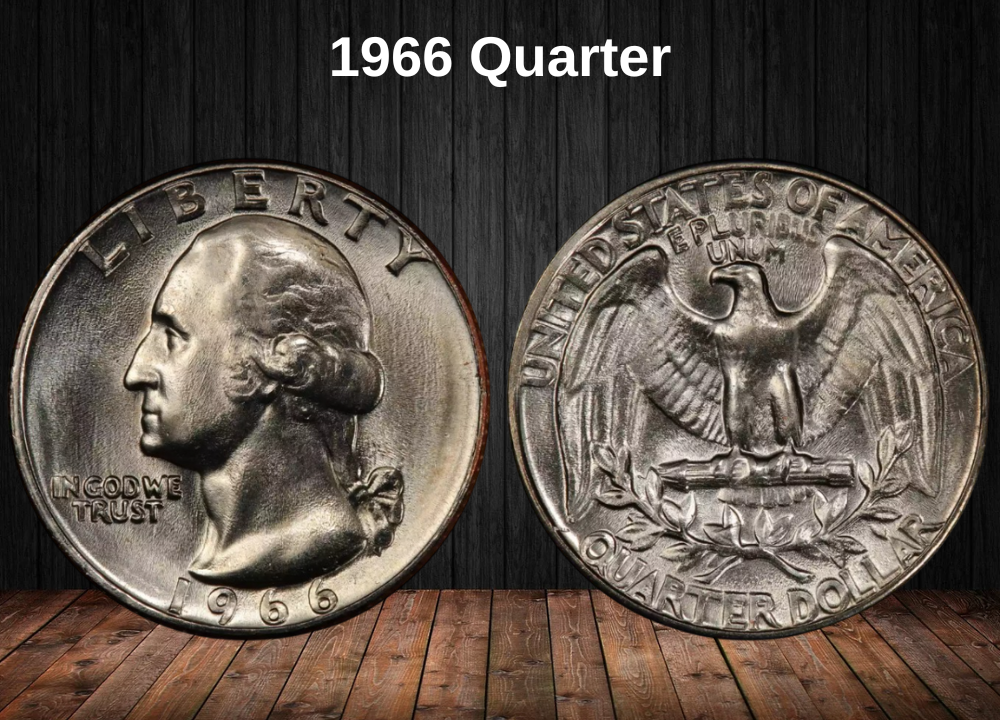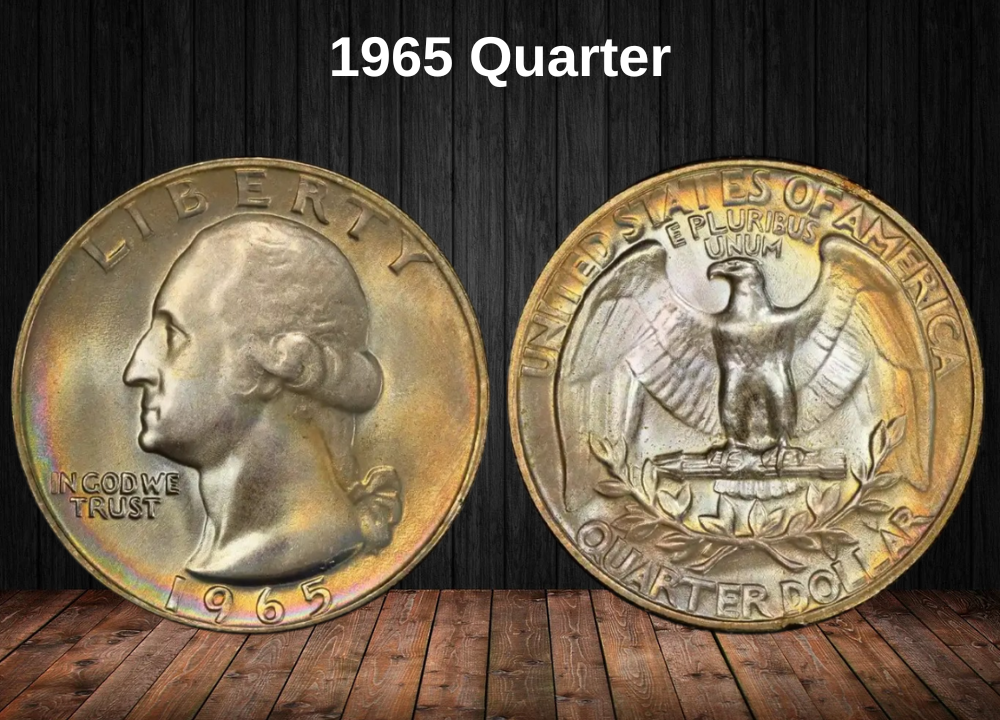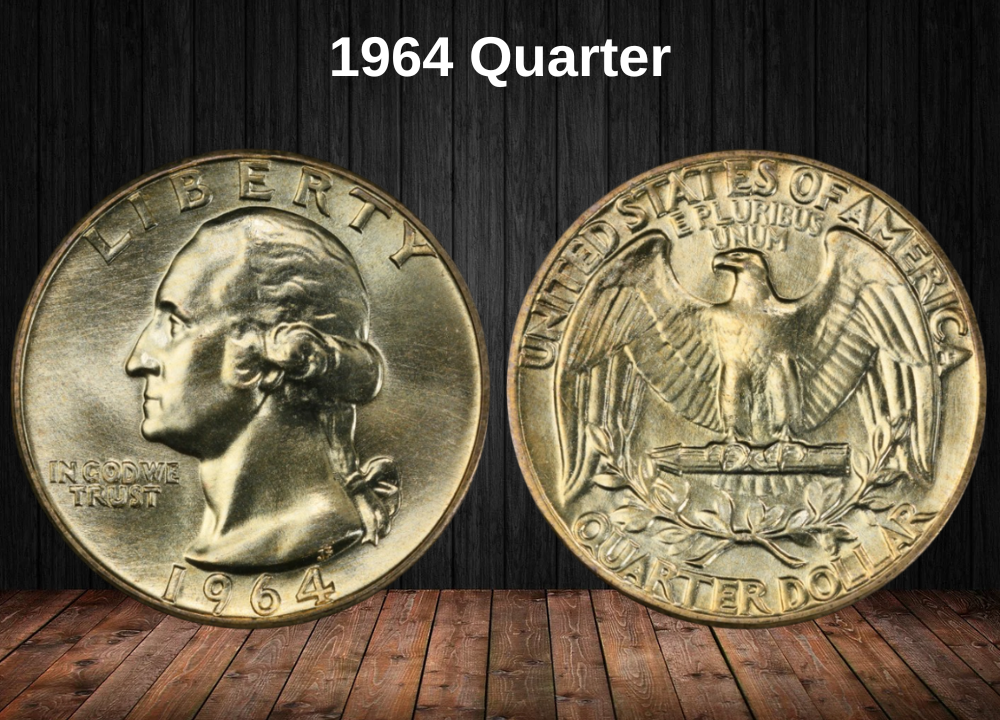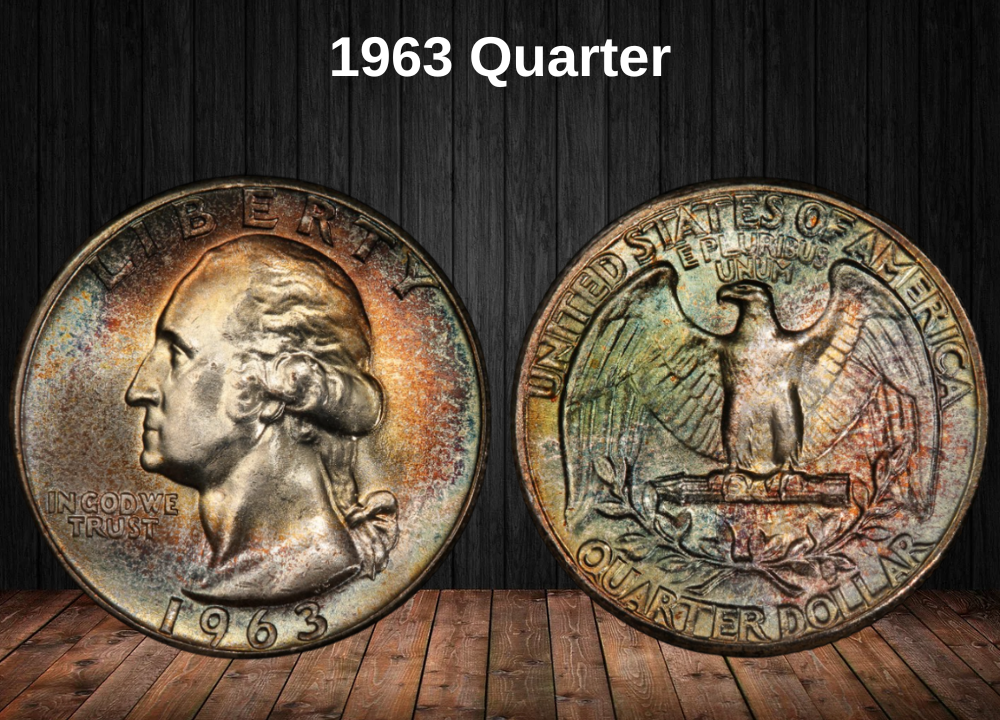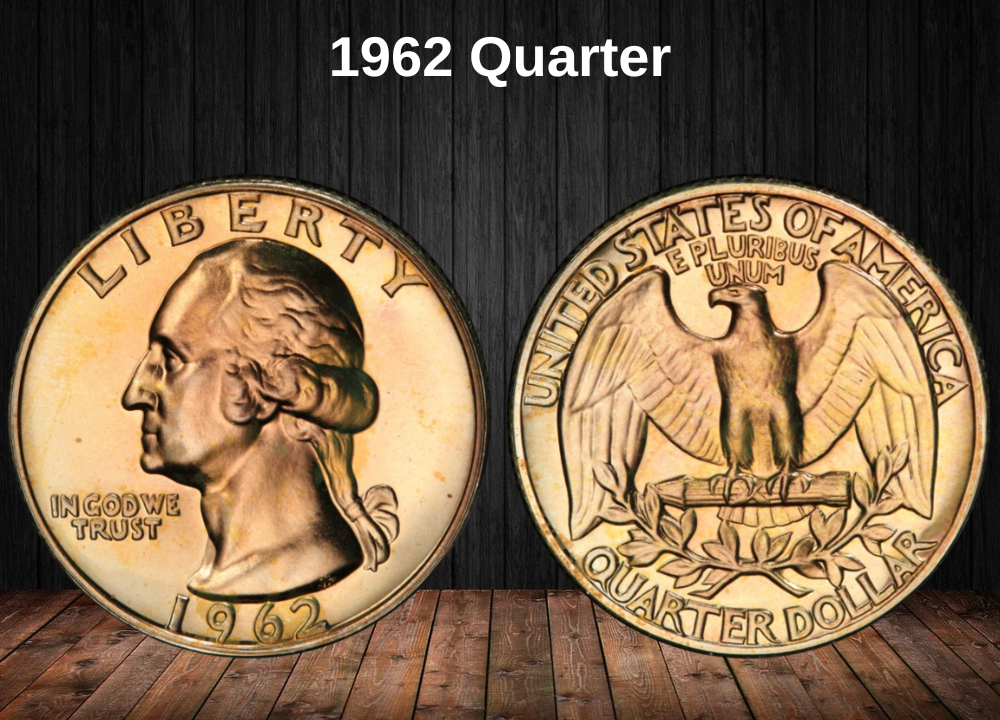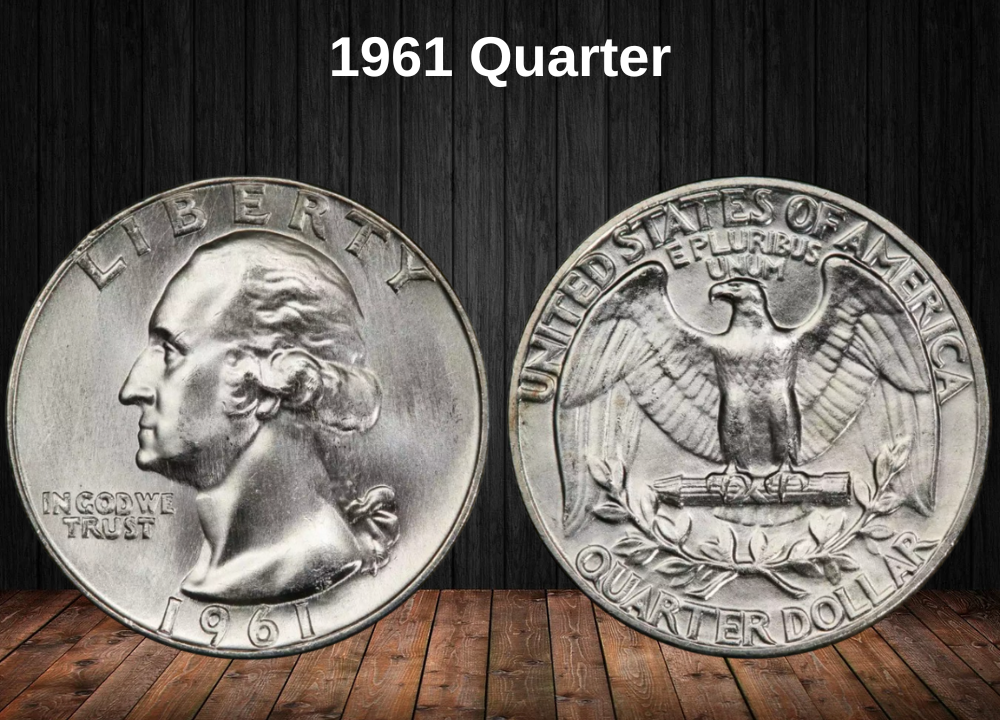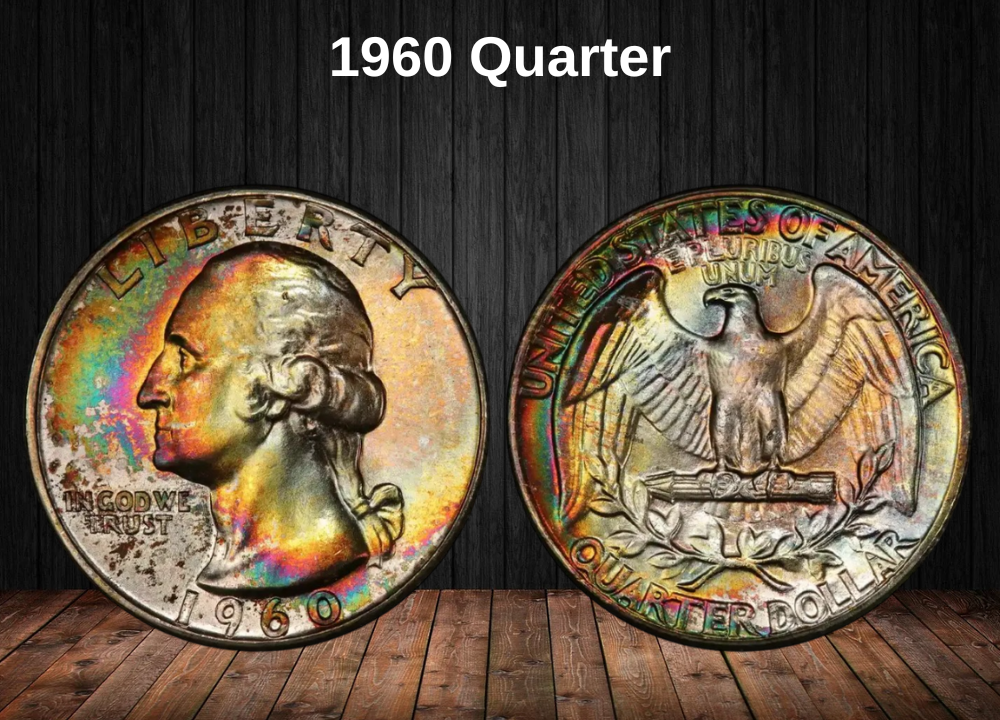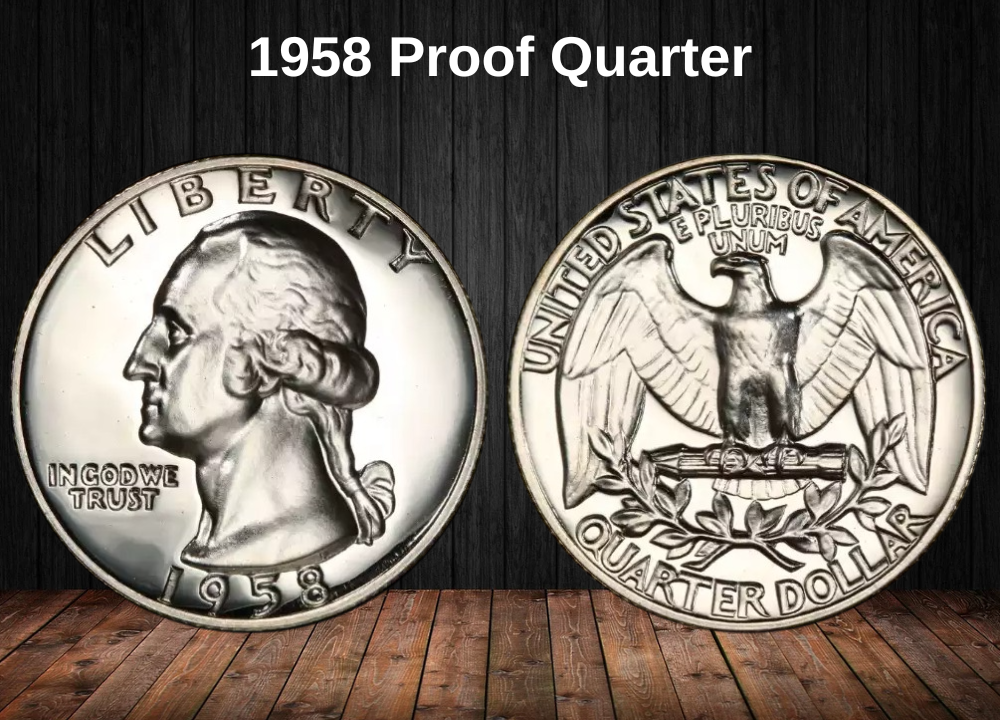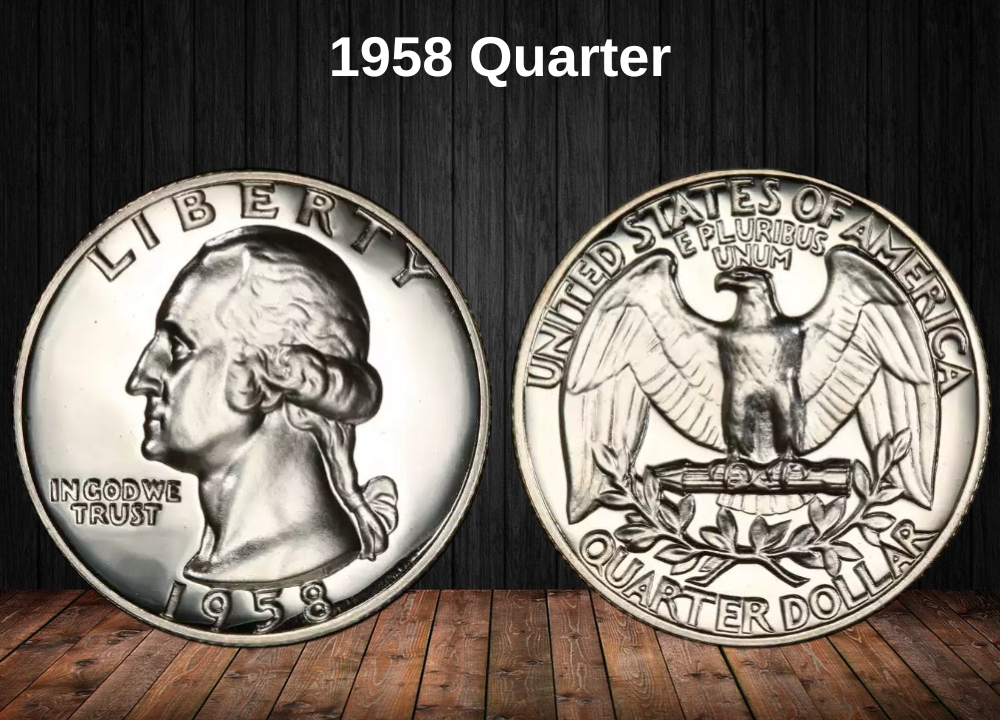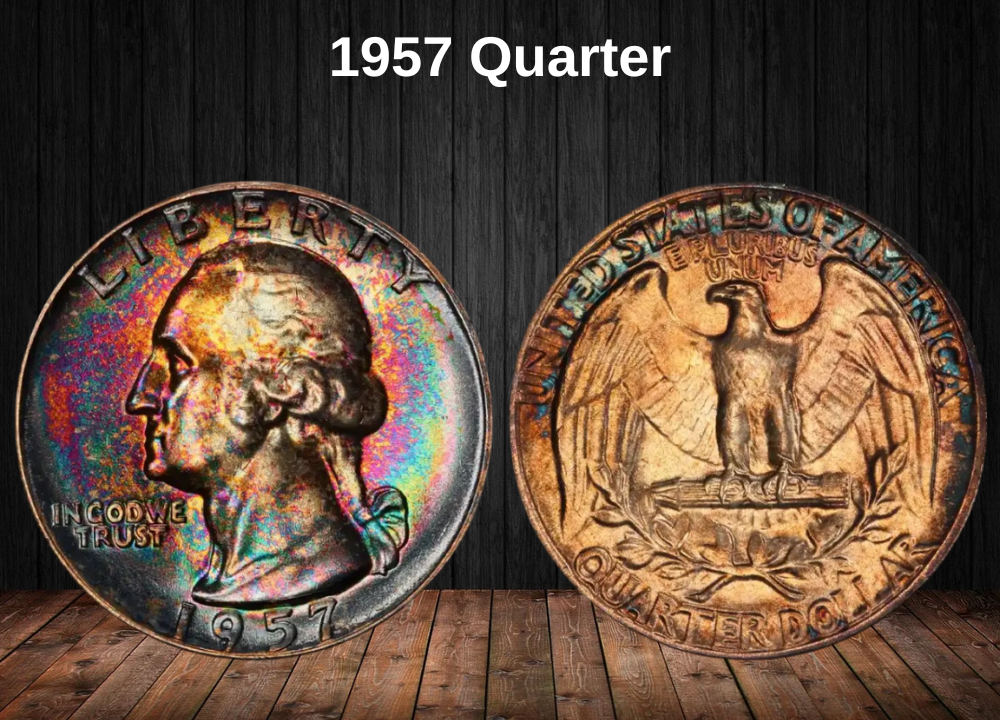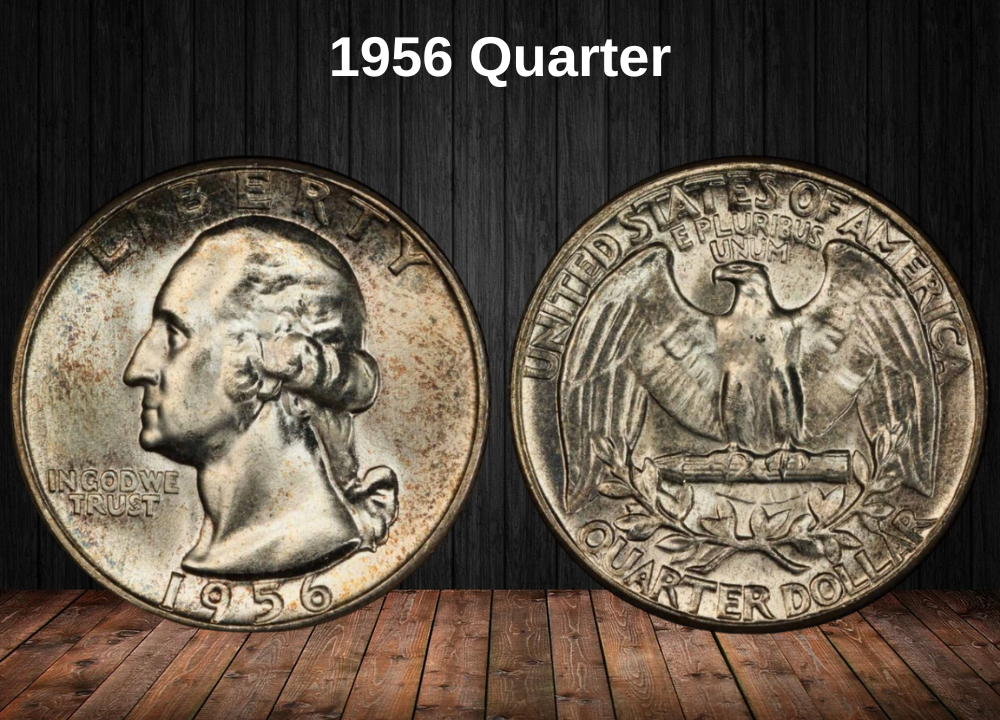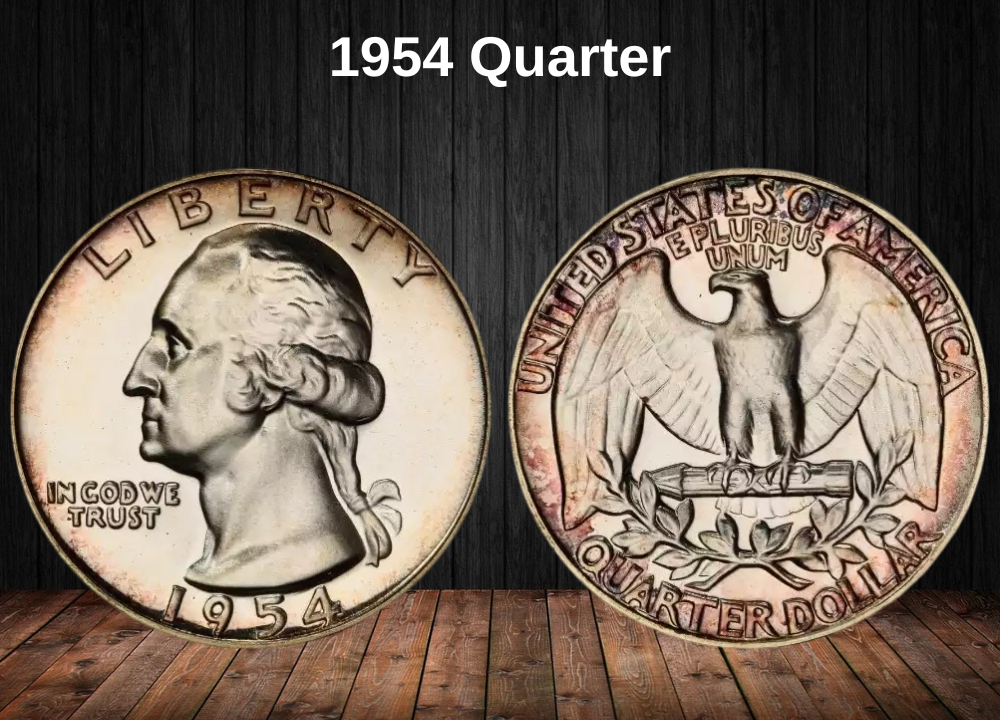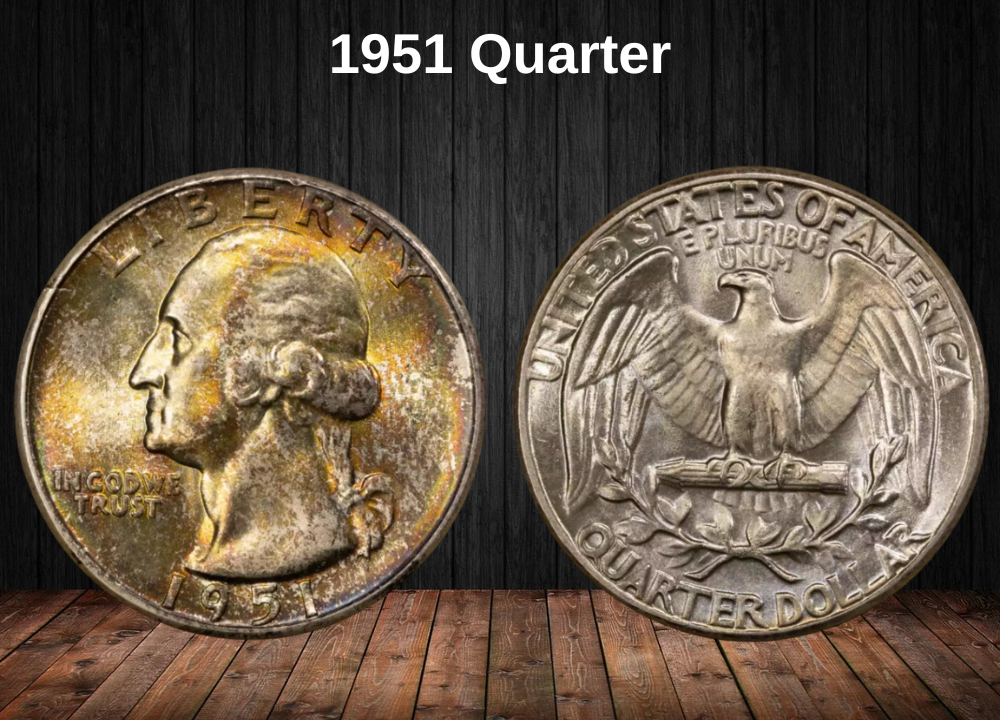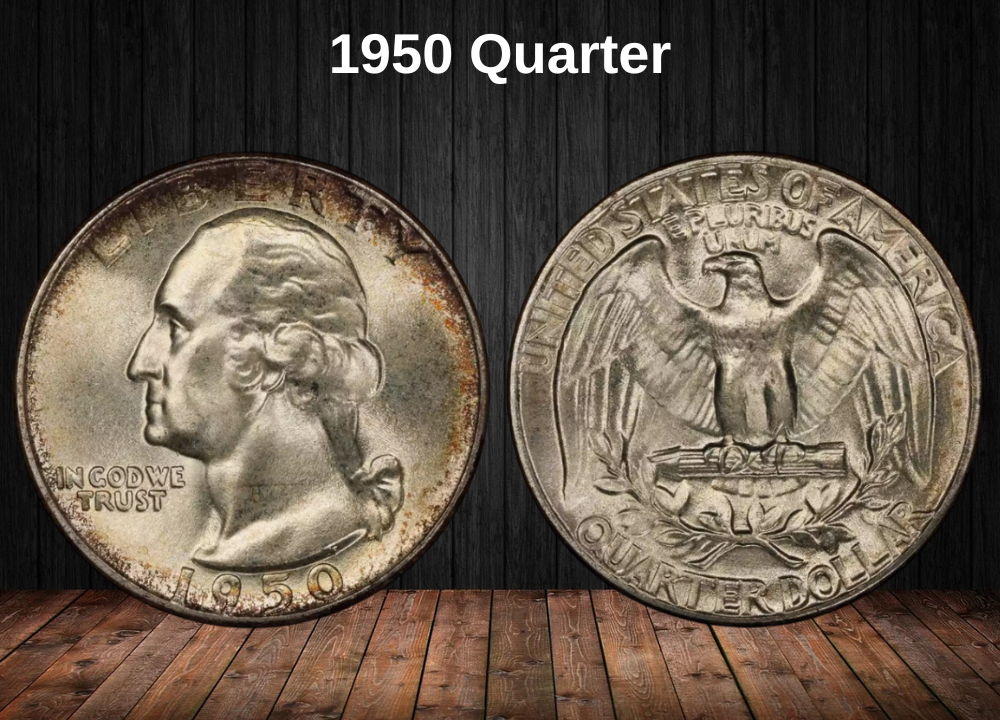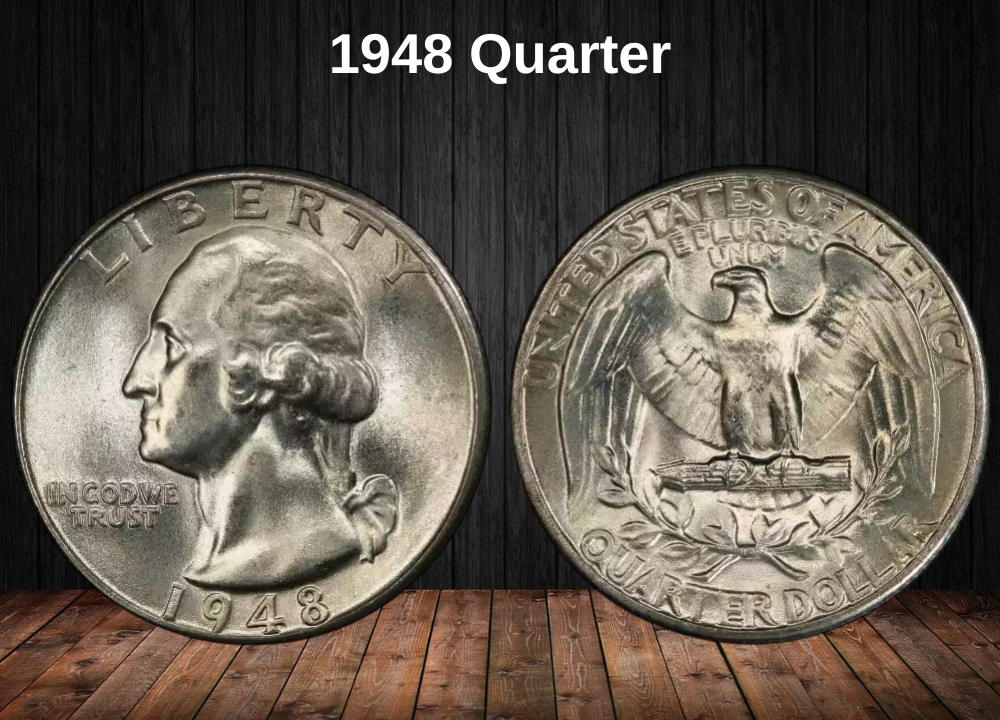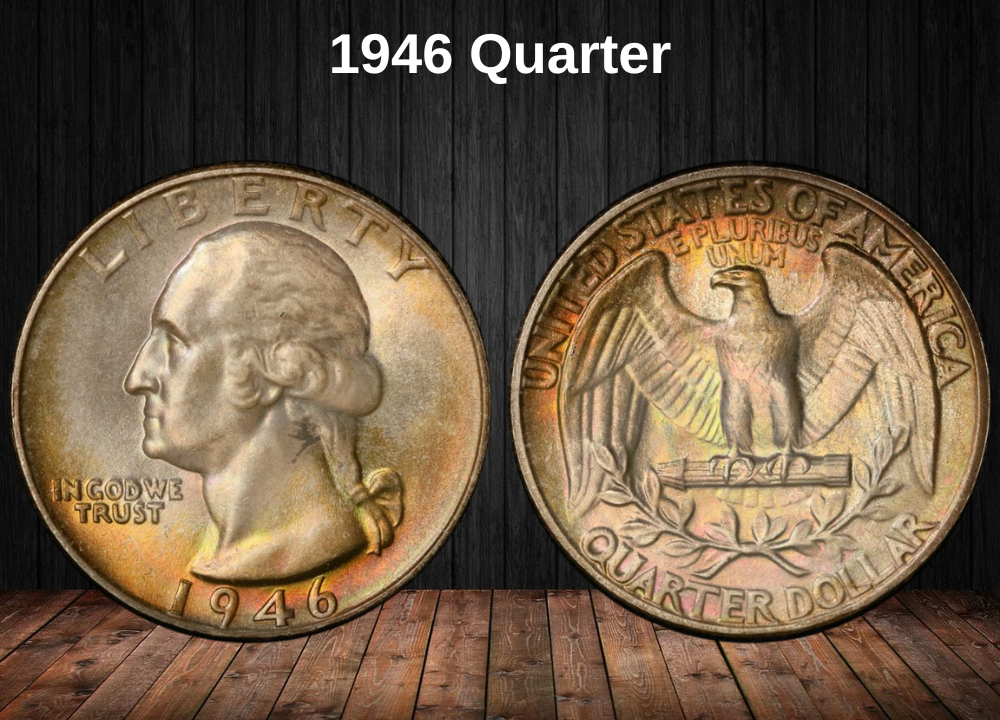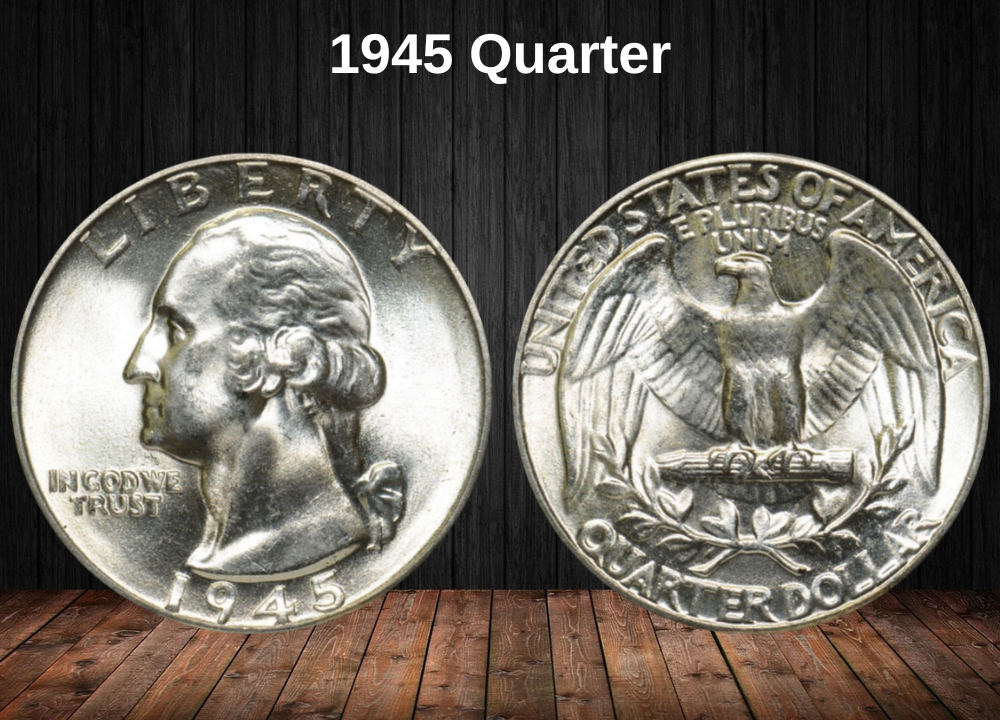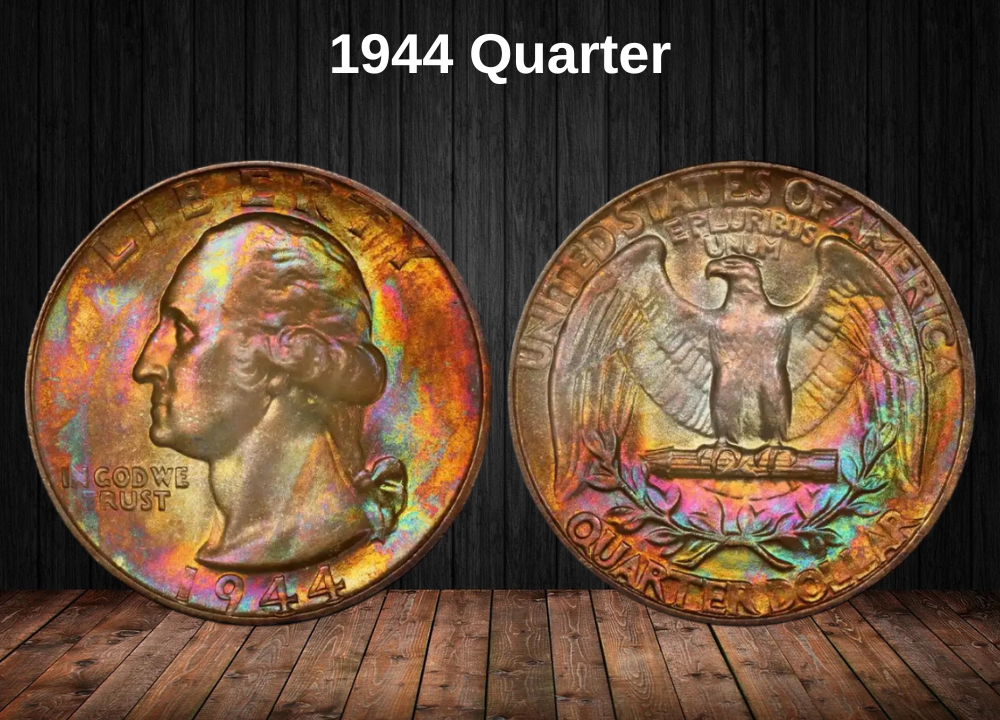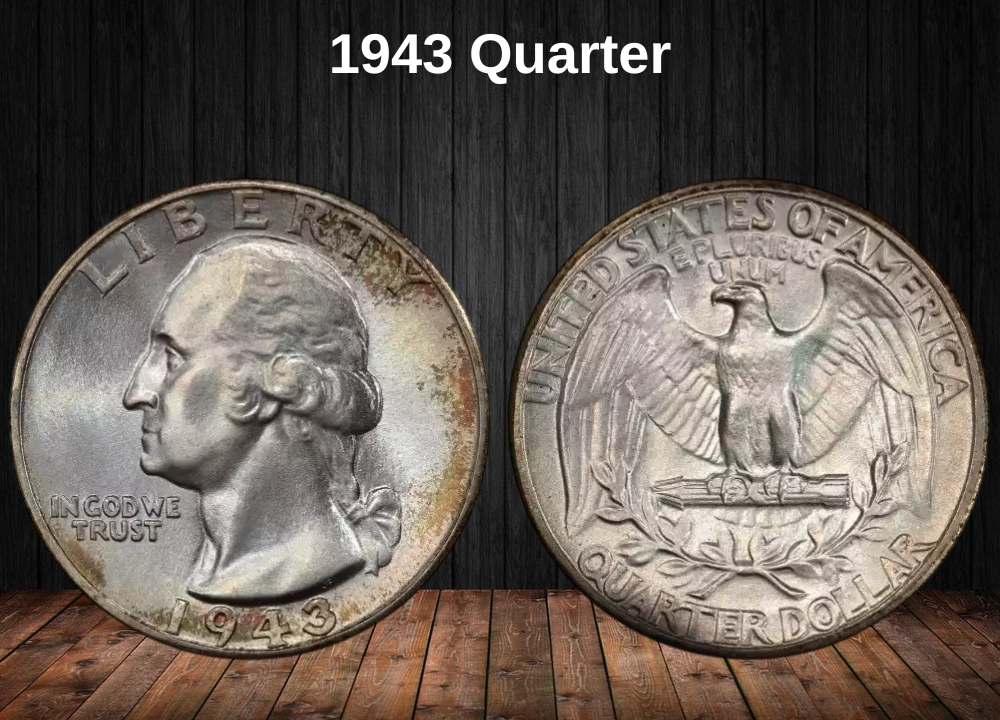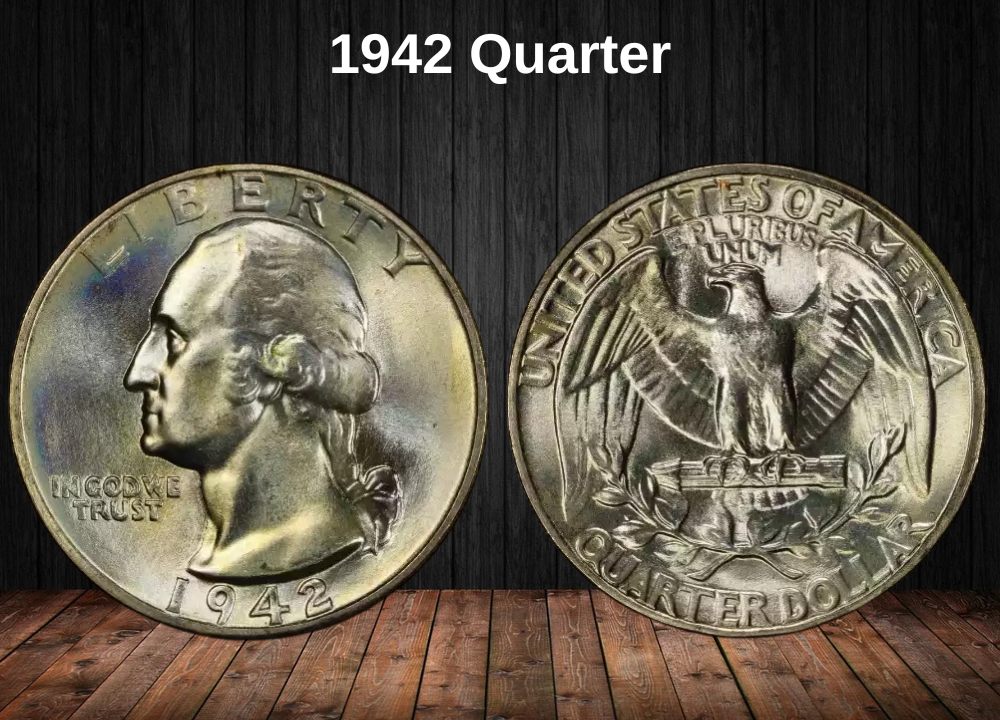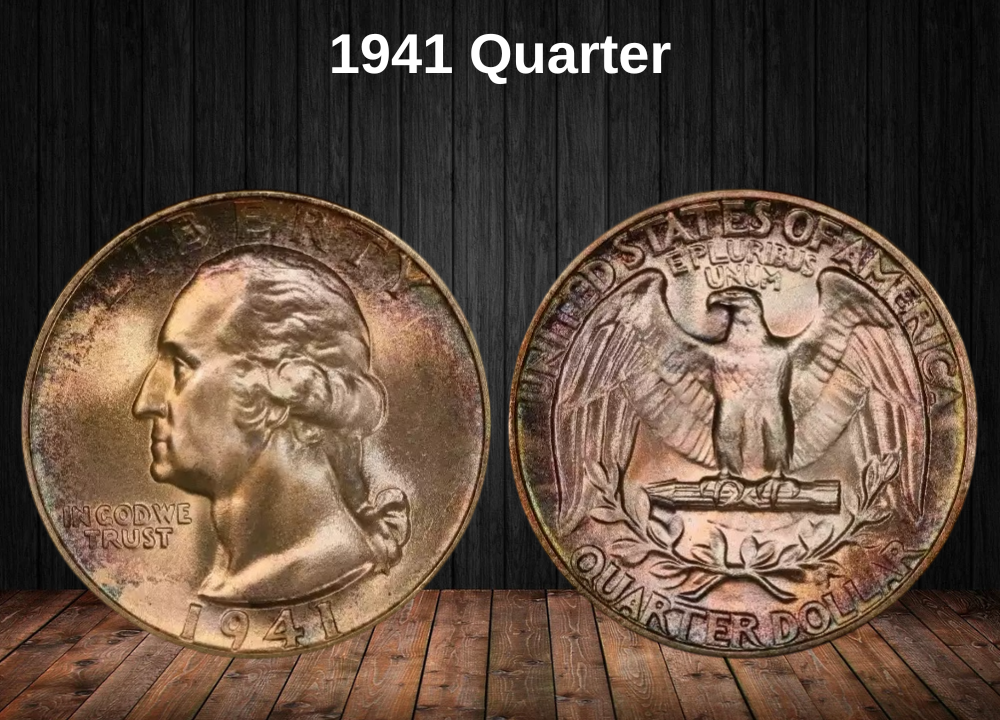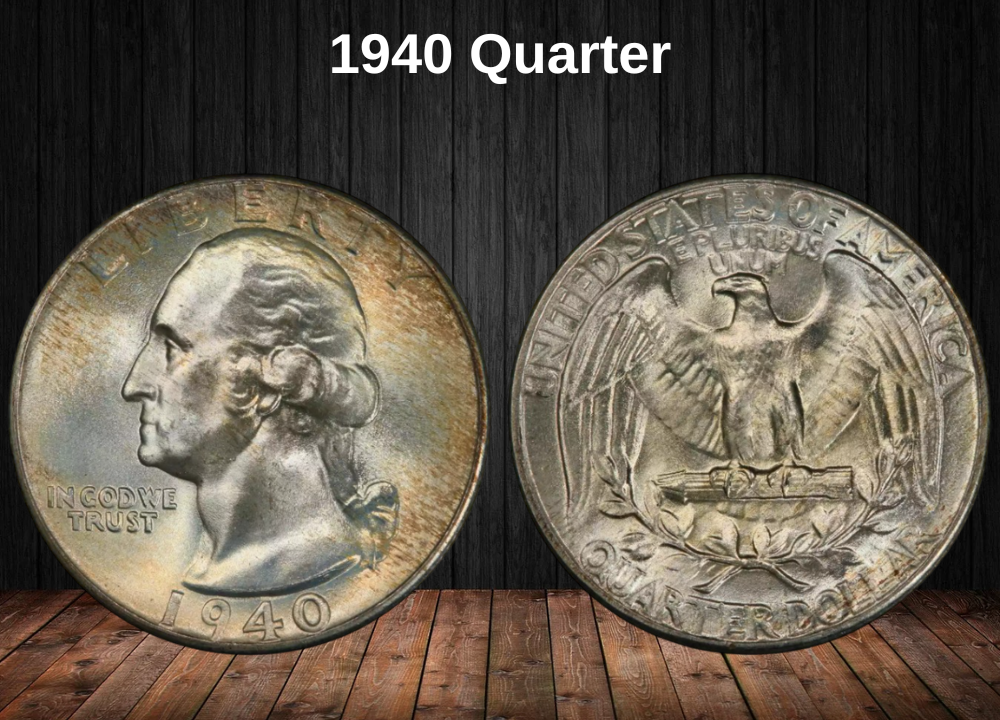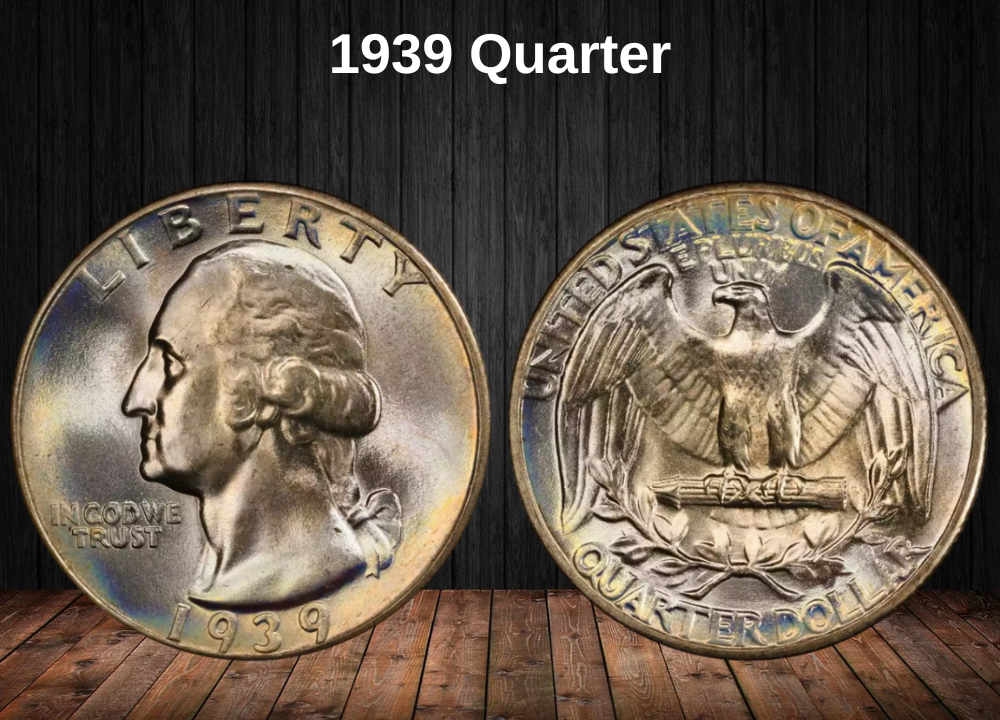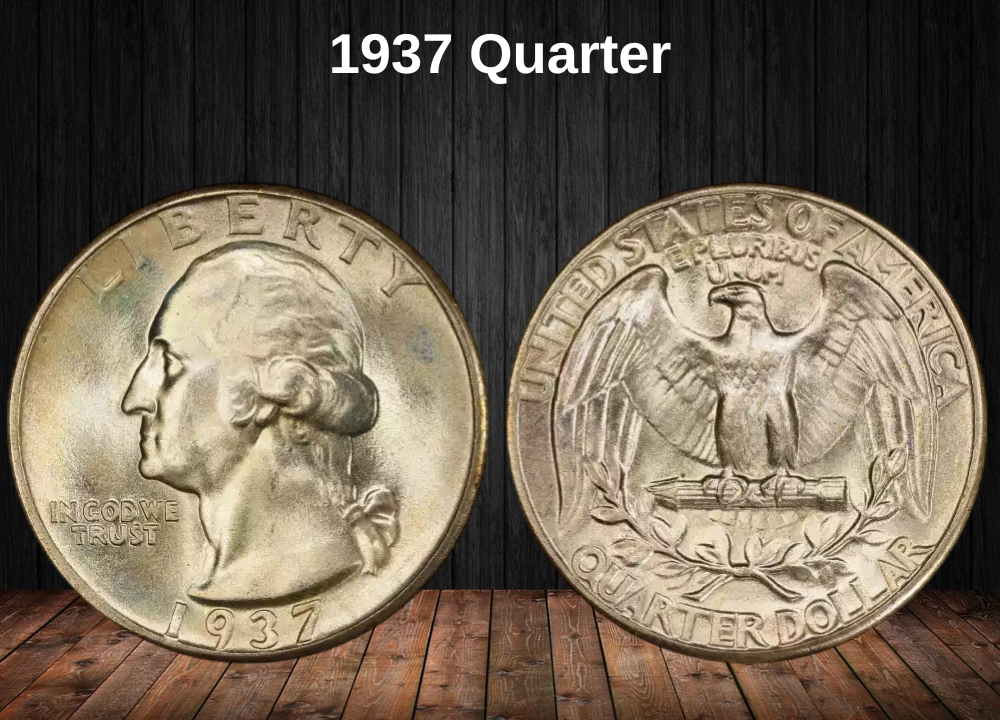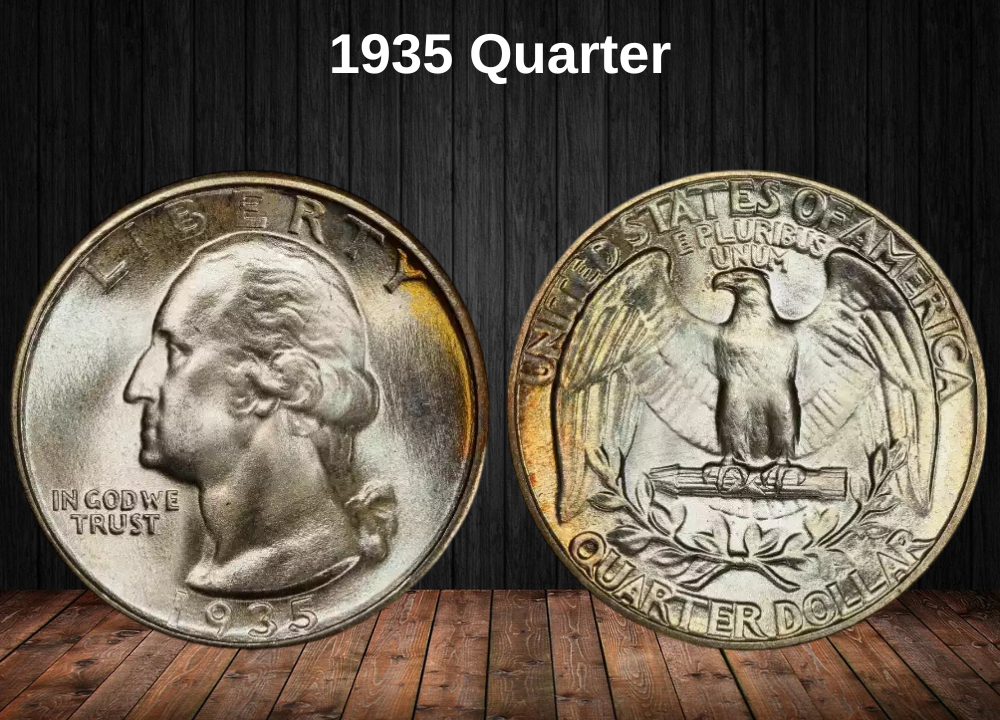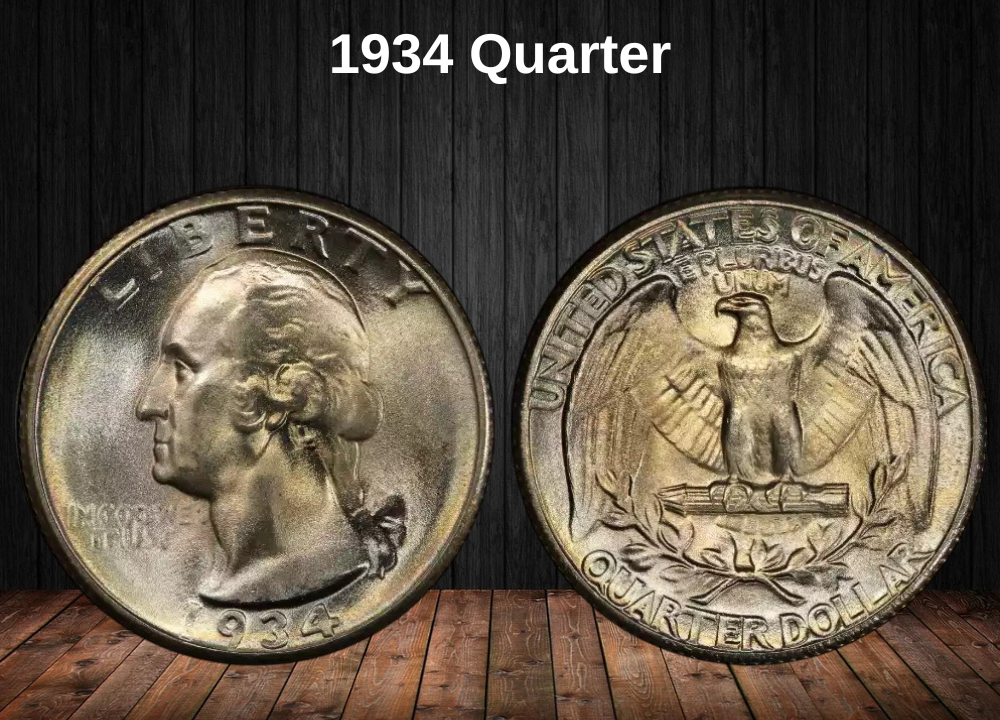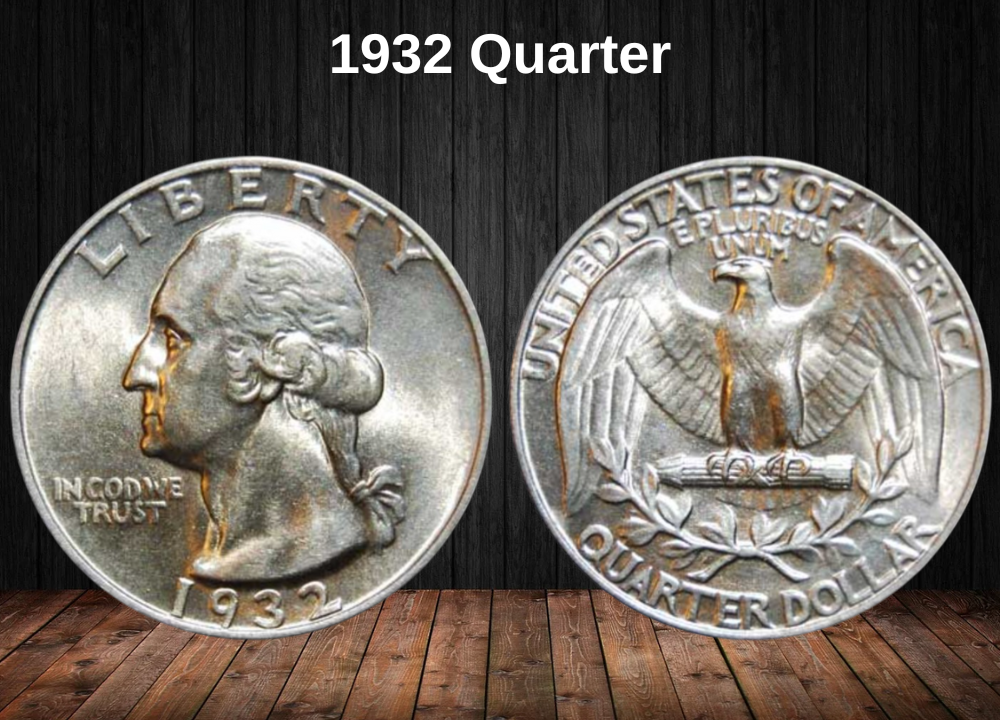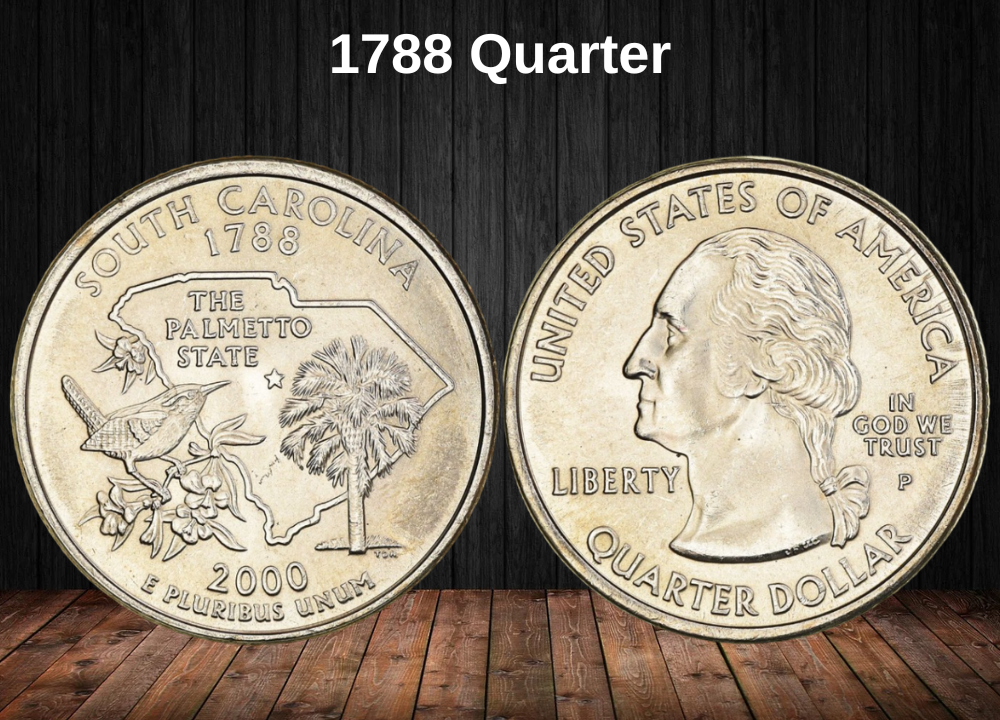The Bicentennial quarter, minted in 1976 to honor America’s 200th birthday, is one of the most recognizable coins in U.S. history. More than 1.6 billion pieces were struck, making them common in circulation. Yet, for collectors, the true fascination lies in the details—mint marks, metal compositions, and striking errors—that can turn an ordinary 25-cent coin into a prized rarity.
While most examples are worth face value, certain varieties have sold at auction for hundreds, even thousands of dollars. In rare cases, extraordinary pieces have reached into the six-figure range, firmly cementing the Bicentennial quarter’s place in numismatic history.
This guide highlights the key varieties and values every collector should know, helping you distinguish between pocket change and hidden treasure.
1976 Quarter Value by Variety
Not every Bicentennial quarter is the same. The U.S. Mint released several varieties, and condition plays a decisive role in determining value. Here’s a breakdown of what collectors look for:
1976 Quarter Value Chart
| Type | Good | Fine | About Uncirculated (AU) | Mint State (MS) | Proof (PR) |
|---|---|---|---|---|---|
| 1976 No Mint Mark (Clad) | — | $1 | $1 | $544 | — |
| 1976 “D” Mint Mark (Clad) | — | $1 | $1 | $313 | — |
| 1976 “S” Silver Quarter | $2 | $2 | $3 | $534 | — |
| 1976 “S” Clad Proof CAM | — | — | — | — | $11 |
| 1976 “S” Clad Proof DCAM | — | — | — | — | $13 |
| 1976 “S” Silver Proof CAM | — | — | — | — | $8 |
| 1976 “S” Silver Proof DCAM | — | — | — | — | $17 |
History of the 1976 Bicentennial Quarter
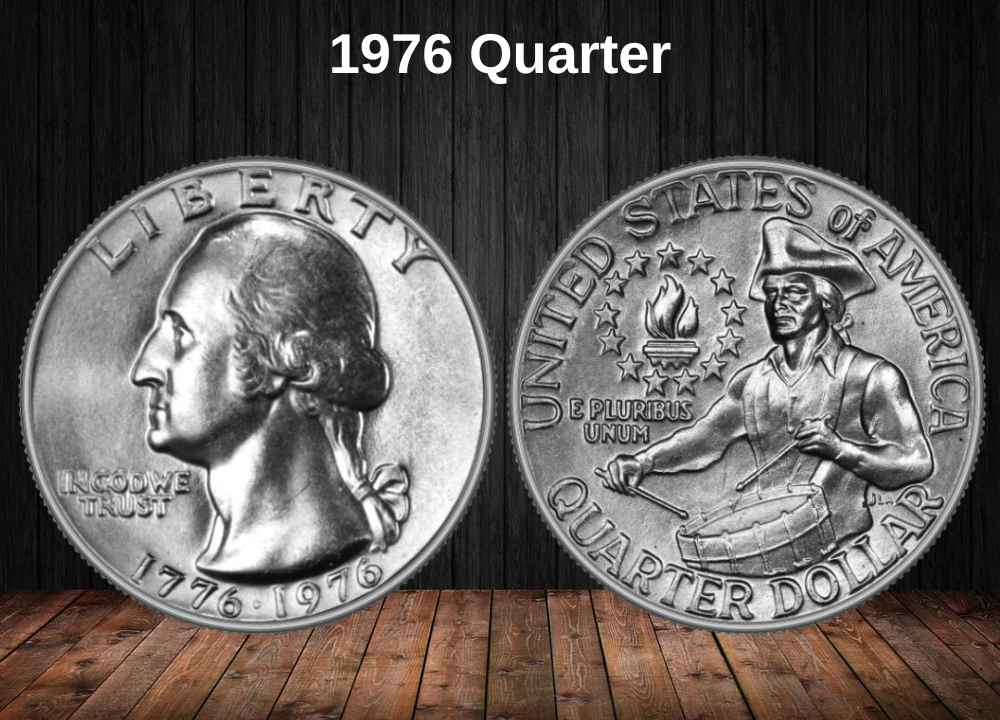
The 1976 Bicentennial quarter stands as one of the most ambitious and celebrated commemorative coinage programs in American history.
As the United States prepared to mark its 200th anniversary of independence, Congress passed legislation in 1973 authorizing new designs for three circulating coins: the quarter, half dollar, and dollar. This was a milestone, as it marked the first major design change on U.S. circulating coinage in decades.
A nationwide design competition was launched, capturing the imagination of artists and collectors alike. The winning entry came from Jack L. Ahr, whose design depicted a colonial drummer, framed by 13 stars and a victory torch—a powerful tribute to the spirit of 1776. This patriotic reverse replaced John Flanagan’s eagle, which had graced the quarter since 1932, though Flanagan’s portrait of George Washington was retained on the obverse.
Production began in 1975, with all coins carrying the dual date “1776–1976”, honoring both the signing of the Declaration of Independence and the Bicentennial celebration. Over 1.6 billion quarters were struck across three U.S. Mint facilities:
- Philadelphia (no mint mark)
- Denver (“D”)
- San Francisco (“S”)
To ensure that Americans could enjoy these commemoratives without sparking a collector-driven shortage, the Mint produced them in massive quantities for general circulation. At the same time, San Francisco catered to collectors, issuing both clad proof strikes and special 40% silver editions—a rare return to precious metal coinage that elevated the program’s appeal.
Although official production concluded in 1976, Bicentennial quarters remained in circulation for decades, mingling with standard Washington quarters and sparking the thrill of discovery for generations of collectors. Today, they remain a beloved centerpiece in U.S. numismatics, valued not only for their artistry but also for the unique moment in history they represent.
Key Features of the 1976 Bicentennial Quarter
The Obverse
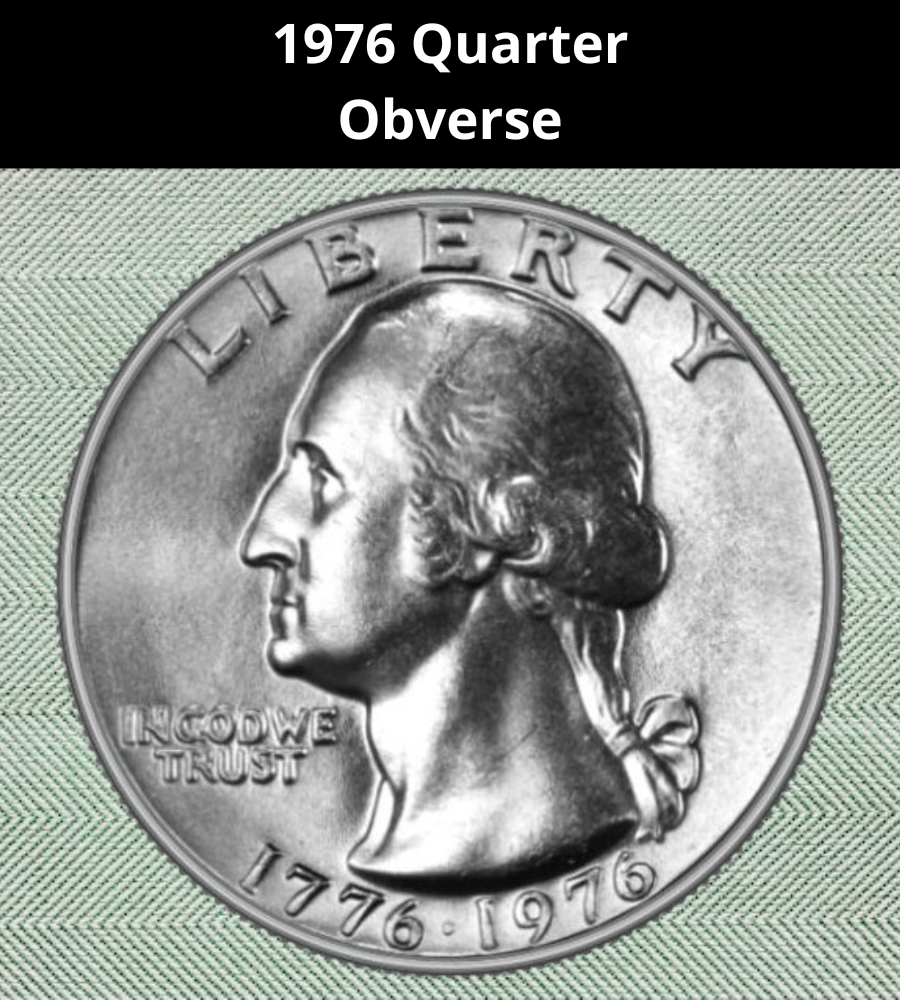
The obverse of the Bicentennial quarter retains John Flanagan’s iconic portrait of George Washington, first introduced in 1932 for the bicentennial of Washington’s birth. Washington faces left in crisp profile, a design that became the standard for the denomination.
Originally, another artist—Laura Gardin Fraser—had been recommended for the honor. But when the quarter was adopted as a permanent coin, the decision fell to Treasury Secretary Andrew W. Mellon, who favored Flanagan’s version.
The Bicentennial obverse differs in only one key detail: the dual date at the bottom of the coin. Instead of a single year, collectors see 1776–1976—commemorating both the signing of the Declaration of Independence and the 200th anniversary of the nation’s founding.
The Reverse
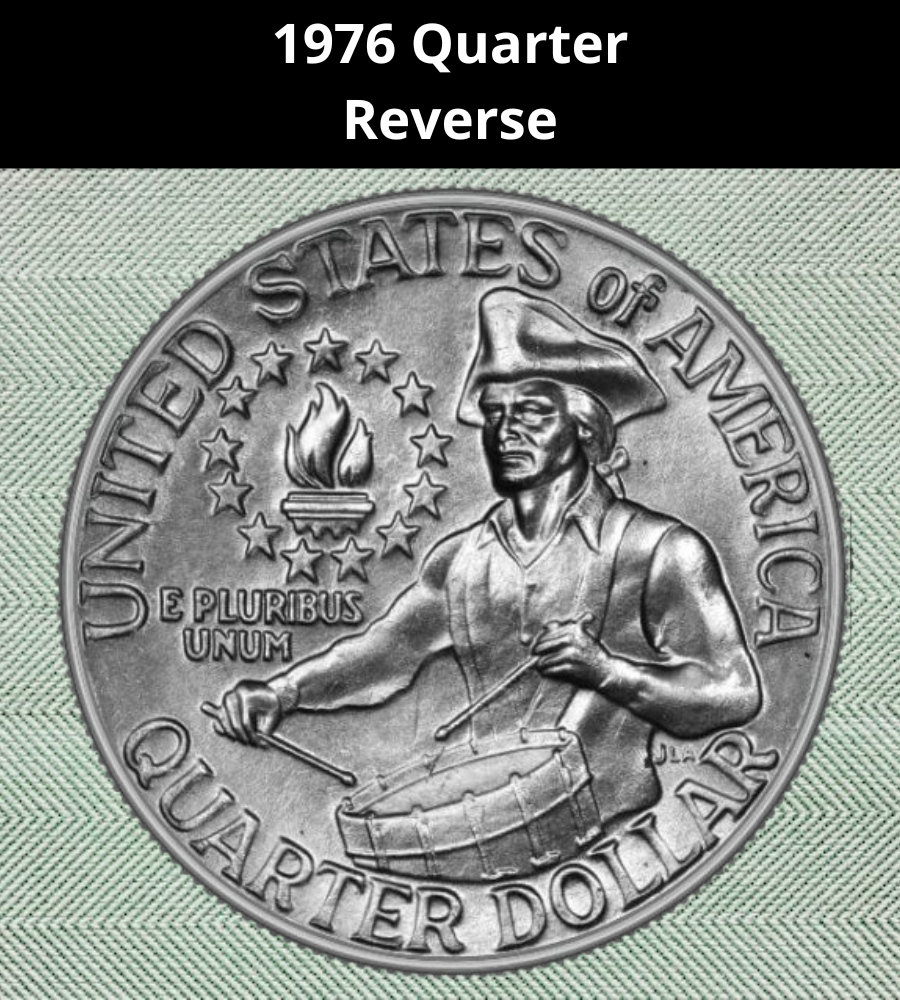
Designed by Jack L. Ahr, the reverse of the Bicentennial quarter is one of the most recognizable and beloved designs in U.S. coinage.
- A colonial drummer stands proudly at center, symbolizing the Revolutionary spirit.
- To his left rises a torch of victory, radiating patriotism and resilience.
- Encircling the torch are 13 stars, each representing one of the original colonies.
- At the top, the nation’s name—UNITED STATES OF AMERICA—arches across the rim.
- Below, the denomination QUARTER DOLLAR is inscribed.
- The national motto, E PLURIBUS UNUM (“From many, one”), appears between the drummer’s arm and the circle of stars.
- Ahr’s initials, JLA, are discreetly placed just above the “A” and “R” in “DOLLAR.”
This patriotic design replaced Flanagan’s familiar eagle reverse for the duration of the Bicentennial celebration.
Other Features
The 1976 quarters were issued in two primary compositions:
- Clad Quarters (Copper-Nickel)
- Core of pure copper, outer layers of 75% copper and 25% nickel.
- Diameter: 24.3 mm
- Weight: 5.67 g
- Standard circulation strikes.
- Silver Quarters (40% Silver, San Francisco Mint)
- Alloy of 40% silver and 60% copper.
- Diameter: 24.3 mm
- Weight: 5.75 g
- Special collector editions (proof and uncirculated).
These dual-metal issues gave collectors an unusual choice between modern clad and a nostalgic return to silver coinage, making the Bicentennial quarter both a commemorative treasure and a circulating classic.
1976 Quarter Grading
Grading makes all the difference when it comes to the 1976 Bicentennial quarter. The exact same coin can be worth just $1 in low grade, or $500+ in high mint state—all depending on its condition.
Most Bicentennial quarters still found in circulation today grade only Good to Fine, showing decades of wear. These have little value beyond face. But in uncirculated grades (MS65 and higher), prices rise sharply as collectors compete for the best-preserved examples.
Key Grading Factors for 1976 Quarters
- Washington’s Portrait → Clean cheek and hairline with minimal contact marks.
- Drummer Boy Design → Look for sharp drumsticks, clear uniform details, and visible folds.
- Victory Torch Flame → A fully defined flame is highly desirable.
- Dual Date “1776–1976” → Must be crisp and fully readable; any doubling or striking errors can increase value significantly.
Proof & Collector Strikes
Coins minted in San Francisco for collectors follow different grading rules:
- Cameo (CAM): Frosted designs stand out against mirrored fields.
- Deep Cameo (DCAM): Strong frosted devices with flawless mirror backgrounds—always bringing premium prices.
- Surface Quality: Must be free of haze, spotting, or scratches to reach the top grades.
Quick Grading Reference
| Grade | Description | Typical Value Range* |
|---|---|---|
| Good (G4) | Heavy wear, major details worn flat | Face value |
| Fine (F12) | Moderate wear, key features visible | $1–$2 |
| About Uncirculated (AU50) | Light wear, nearly all details intact | $5–$15 |
| Mint State (MS65) | Sharp strike, full luster, minimal marks | $100–$500+ |
| Proof DCAM (PR/DCAM) | Strong cameo contrast, perfect surfaces | $20–$100+ |
*Values vary depending on variety, mint mark, and current market demand.
1976 Quarter Value Guides
The 1976 Bicentennial quarter exists in seven distinct varieties, each with its own mintage figures, rarity, and collector appeal.
Circulation Strikes
These were struck for everyday use and are the most common:
- 1976 Clad (No Mint Mark, Philadelphia) – 809,784,016 minted
- 1976-D Clad (Denver) – 860,118,839 minted
San Francisco Silver Issues
Special collector strikes in 40% silver:
- 1976-S Silver – 11,000,000 minted
- 1976-S Silver CAM – Unknown mintage
- 1976-S Silver DCAM – 4,000,000 minted
San Francisco Clad Proofs
Clad proofs were struck only for collectors, showcasing superior strike quality:
- 1976-S Clad CAM – Unknown mintage
- 1976-S Clad DCAM – 7,059,099 minted
Collector Insights
- Philadelphia and Denver together produced over 1.6 billion coins, ensuring their wide availability in circulation.
- San Francisco focused on proof and silver editions, crafted with mirror-like fields and frosted details, designed specifically for numismatists.
- The silver issues carry dual appeal—both as collectible rarities and for their intrinsic precious metal value.
- Cameo (CAM) and Deep Cameo (DCAM) finishes remain highly sought after, as they display the most dramatic visual contrast between frosted designs and mirrored surfaces.
1976 Clad Quarter Value
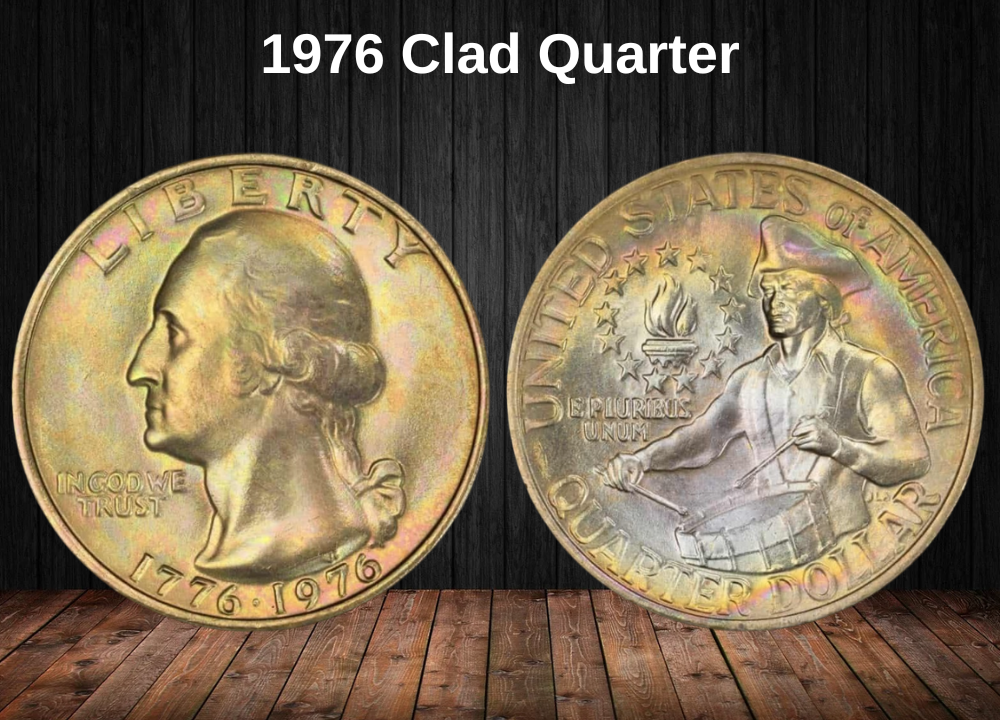
The 1976 Clad Bicentennial quarter remains the most accessible gateway into Bicentennial coin collecting. With over 1.6 billion pieces struck between Philadelphia and Denver, it’s a coin that virtually every American has handled. Yet within this ocean of circulation strikes hide remarkable rarities.
The appeal of this variety does not come from scarcity—it comes from condition and striking anomalies. While circulated examples hold little more than face value, MS67+ survivors are genuinely rare, commanding strong premiums at auction. Even more dramatic are error varieties—such as doubled dies, off-center strikes, or planchet flaws—which can elevate a common quarter into a four-figure collectible.
For both novice collectors and seasoned numismatists, the 1976 Clad quarter represents a perfect blend of historic significance, broad availability, and occasional exceptional treasures.
1976 Clad Quarter Price / Grade Chart
Latest Auction Records – Updated September 2, 2025
| Date | Auction House | Grade | Price Realized |
|---|---|---|---|
| 08/24 | HA | MS62 | $1,020 |
| 08/24 | HA | MS65 | $1,920 |
| 08/24 | HA | MS64 | $2,520 |
| 08/24 | HA | MS63 | $1,680 |
| 08/24 | HA | AU58 | $1,020 |
| 06/24 | SB | MS66 | $360 |
| 06/24 | SB | MS65 | $240 |
| 04/23 | LM | MS67 | $1,821 |
| 01/23 | DL | MS63 | $12 |
| 01/23 | DL | MS65 | $13 |
Note: Prices reflect individual sales and may vary depending on coin eye appeal, strike quality, and auction venue.
Market Activity – 1976 Clad Quarter
Recent auction records show that collector demand for premium clad Bicentennial quarters remains strong. While lower-grade pieces bring modest returns, sharp, problem-free high-grade examples continue to surprise at auction.
For broader context, compare this issue’s market performance with other entries in the Washington Quarter Market Activity Ranking (Top 100), where the Bicentennial clad quarter consistently ranks as a collector favorite.
1976-D Clad Quarter Value
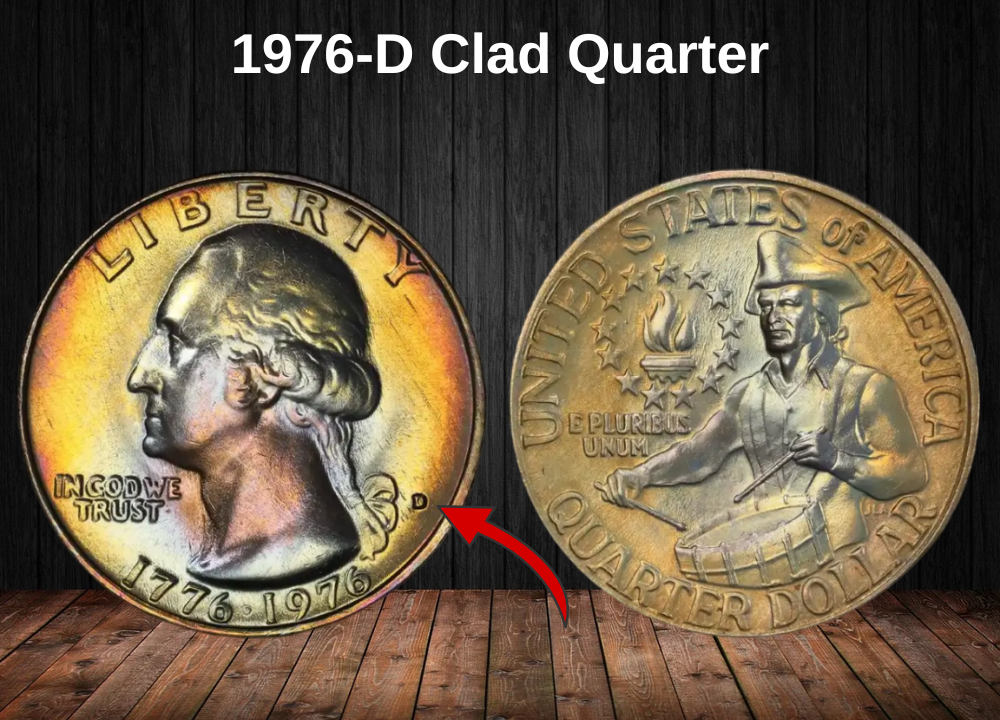
The 1976-D Bicentennial quarter, struck at the Denver Mint, holds a special place in numismatic circles. Collectors often regard Denver issues as superior to their Philadelphia counterparts, thanks to their sharper strikes and fewer bag marks.
Among these coins, error varieties are especially prized—most notably the filled “D” mintmark and rare double die obverse specimens. These anomalies transform an ordinary Bicentennial quarter into a standout collectible.
High-grade survivors are the true gems: while billions were minted, examples in MS68 and above are exceedingly rare. Their scarcity makes them condition rarities, highly coveted and capable of reaching impressive auction results.
1976-D Clad Quarter Price / Grade Chart
Latest Auction Records – Updated September 2, 2025
| Date | Auction House | Grade | Price Realized |
|---|---|---|---|
| 08/24 | HA | MS63 | $1,320 |
| 05/24 | HA | MS68 | $990 |
| 08/22 | HA | MS67 | $71 |
| 08/22 | HA | MS67 | $73 |
| 05/22 | HA | MS68 | $1,740 |
| 11/21 | HA | MS67 | $91 |
| 08/21 | HA | MS67 | $33 |
| 03/20 | DL | MS67 | $90 |
| 01/18 | LM | MS68 | $5,170 |
| 01/17 | HA | MS68 | $6,463 |
Note: Prices reflect individual sales and are influenced by strike sharpness, luster, and error varieties.
Market Activity – 1976-D Clad Quarter
Historical auction records show consistent demand for Denver Bicentennial quarters, with prices rising steeply in the highest grades. While MS67 examples remain affordable, the leap to MS68 transforms the coin into a premium rarity.
Error specimens—particularly filled “D” mintmarks and doubled dies—continue to draw collector enthusiasm, reinforcing the Denver quarter’s position as one of the most exciting varieties of the Bicentennial series.
1976-S Silver Quarter Value
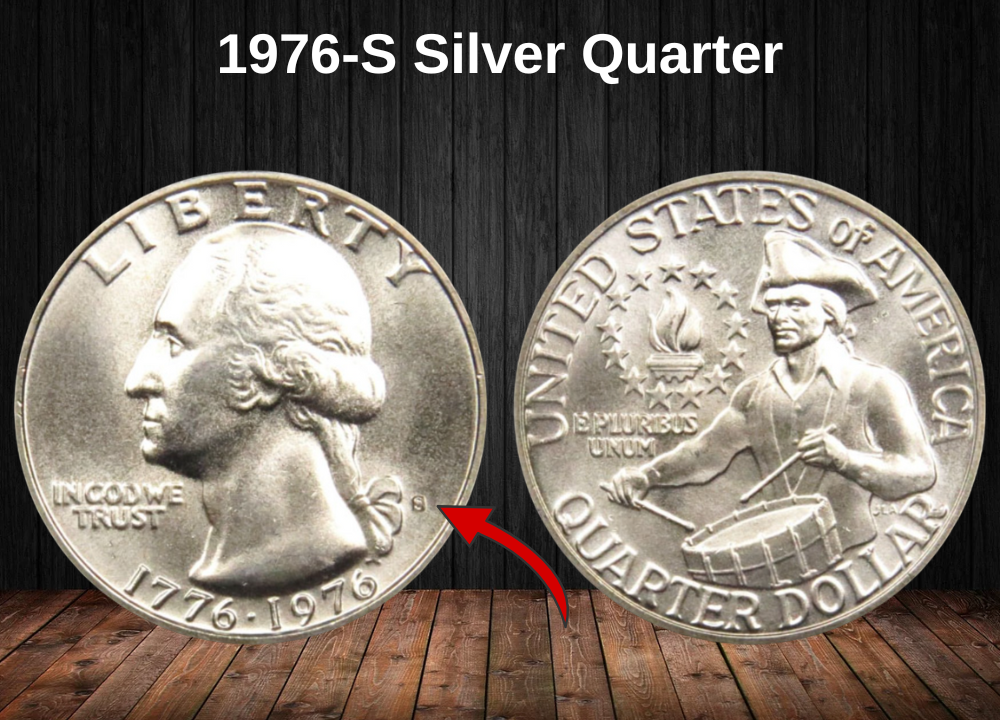
The 1976-S Silver Bicentennial quarter is the crown jewel of the series, struck exclusively for collectors and composed of 40% silver rather than the standard copper-nickel clad.
This silver content not only provides intrinsic bullion value, but also adds stability during economic downturns—making these quarters both a numismatic treasure and a tangible investment. Their strike quality is superior, with sharp definition in the drummer boy reverse and crisp “S” mintmark, a hallmark of San Francisco Mint craftsmanship.
The limited mintage, combined with their collector-only distribution, ensures these coins hold a fundamentally different value proposition compared to circulation strikes. For that reason, they consistently command higher premiums on the market.
1976-S Silver Quarter Price / Grade Chart
Latest Auction Records – Updated September 2, 2025
| Date | Auction House | Grade | Price Realized |
|---|---|---|---|
| 11/22 | HA | MS68 | $73 |
| 10/22 | HA | MS67 | $372 |
| 10/22 | DL | MS68 | $115 |
| 09/22 | DL | MS67 | $60 |
| 08/22 | HA | MS68 | $129 |
| 08/22 | HA | MS68 | $104 |
| 06/22 | DL | MS66 | $65 |
| 12/21 | HA | MS69 | $6,600 |
| 11/21 | HA | MS68 | $76 |
| 07/21 | HA | MS68 | $99 |
Note: Prices reflect market demand, grade rarity, and auction competition. MS69 examples represent extreme rarities, achieving exceptional premiums.
Market Activity – 1976-S Silver Quarter
Auction data confirms sustained collector enthusiasm for this precious metal issue. While lower Mint State coins remain affordable, superb-gem examples (MS68–MS69) continue to set records, with one MS69 bringing $6,600 in 2021.
This performance underscores the enduring appeal of the 1976-S Silver quarter: a coin that blends historic commemoration, silver value, and collector prestige.
1976-S Clad CAM Quarter Value
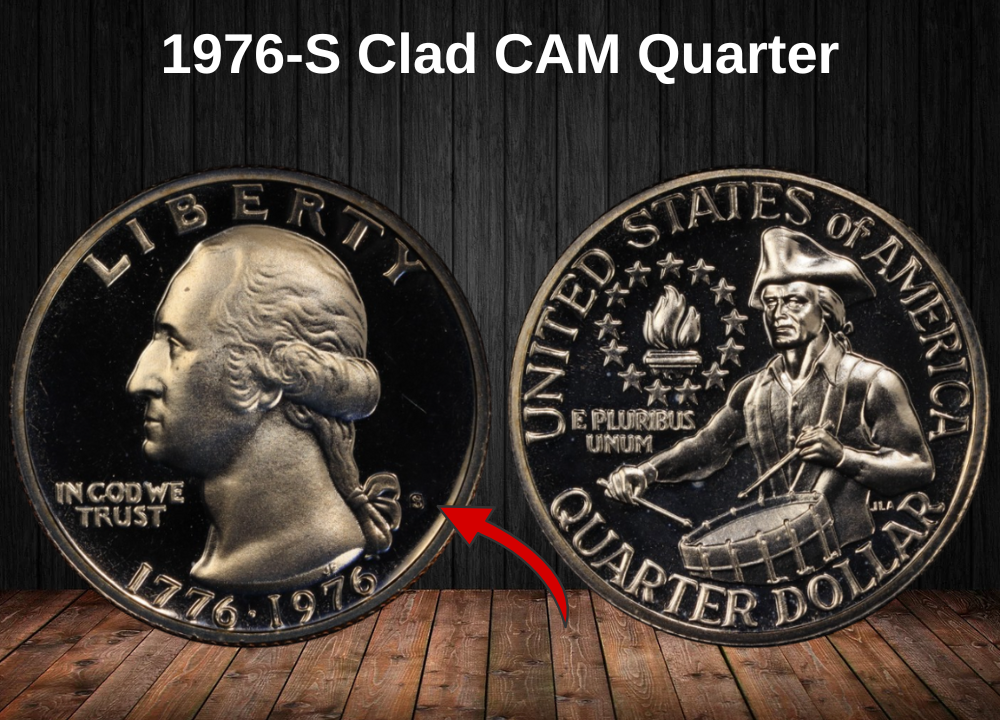
The 1976-S Clad Cameo (CAM) Bicentennial quarter represents San Francisco’s entry-level proof issue, offering collectors a coin that combines historic significance with affordable accessibility.
Unlike circulation strikes, these quarters were struck multiple times using highly polished dies, resulting in sharper details and mirror-like fields. The Cameo designation (CAM) reflects a moderate contrast between frosted devices and reflective surfaces—less dramatic than Deep Cameo (DCAM) coins, but still far more eye-catching than standard proofs.
These proofs were sold exclusively in collector sets and never released for circulation, meaning most examples remain in pristine condition. For many collectors, the 1976-S Clad CAM quarter provides an affordable gateway into premium Bicentennial issues without the higher costs associated with the silver varieties.
1976-S Clad CAM Quarter Price / Grade Chart
Latest Auction Records – Updated September 2, 2025
| Date | Auction House | Grade | Price Realized |
|---|---|---|---|
| 06/13 | GC | PR66 | $6 |
| 06/13 | GC | PR65 | $6 |
| 10/12 | GC | PR66 | $7 |
| 05/12 | HA | PR69 | $15 |
| 05/12 | GC | PR69 | $19 |
| 04/12 | HA | PR69 | $15 |
| 04/12 | HA | PR69 | $16 |
| 11/11 | GC | PR68 | $13 |
| 05/04 | HA | PR69 | $18 |
| 04/04 | HA | PR68 | $18 |
Note: Prices remain modest, reflecting the strong availability of these proof issues. Top-graded PR69 examples carry the most collector appeal.
Market Activity – 1976-S Clad CAM Quarter
Auction records show steady demand for this proof variety, particularly among collectors seeking a balance between premium quality and affordability. While not commanding the dramatic prices of silver proofs or DCAMs, the 1976-S Clad CAM quarter has proven itself as a reliable entry point into Bicentennial proof collecting.
1976-S Clad DCAM Quarter Value
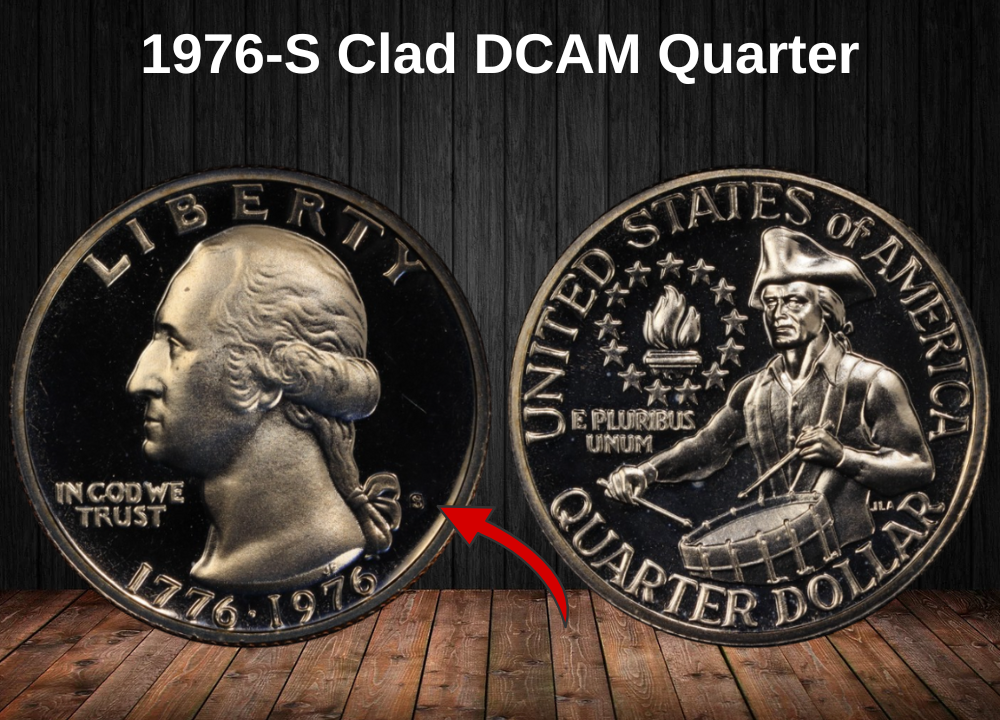
The 1976-S Clad Deep Cameo (DCAM) Bicentennial quarter represents the highest standard of proof production from the San Francisco Mint. With its bold black-and-white contrast, this coin showcases frosted devices of the drummer boy design set against deeply mirrored fields, producing a dramatic visual effect beloved by collectors.
DCAM proofs are the result of meticulous die preparation and multiple high-pressure strikes on specially polished planchets. This process creates a superior level of detail and finish compared to standard Cameo proofs, elevating the coin’s artistry and appeal.
Although struck in clad rather than silver, these coins deliver the same aesthetic impact as precious metal proofs—but at a more affordable price. The balance of stunning presentation and accessible pricing has made the 1976-S Clad DCAM quarter a consistent favorite among modern proof collectors.
1976-S Clad DCAM Quarter Price / Grade Chart
Latest Auction Records – Updated September 2, 2025
| Date | Auction House | Grade | Price Realized |
|---|---|---|---|
| 08/23 | HA | PR70 | $114 |
| 07/23 | HA | PR70 | $119 |
| 11/22 | HA | PR70 | $149 |
| 05/22 | HA | PR70 | $154 |
| 03/22 | HA | PR70 | $79 |
| 04/21 | DL | PR69 | $50 |
| 10/17 | DL | PR69 | $17 |
| 03/15 | DL | PR69 | $17 |
| 12/14 | GC | PR69 | $7 |
| 12/14 | GC | PR69 | $9 |
Note: Prices vary widely depending on grade. Coins certified PR70 DCAM command the strongest premiums, while PR69 examples remain highly affordable.
Market Activity – 1976-S Clad DCAM Quarter
Recent auction records confirm that collector enthusiasm remains strong for these visually striking proofs. High-grade PR70 DCAMs continue to achieve steady premiums, while PR69s offer an entry point for collectors seeking Bicentennial proof artistry at modest prices.
The Deep Cameo designation ensures these coins stand out in any collection, bridging the gap between affordability and top-tier visual appeal.
1976-S Silver CAM Quarter Value
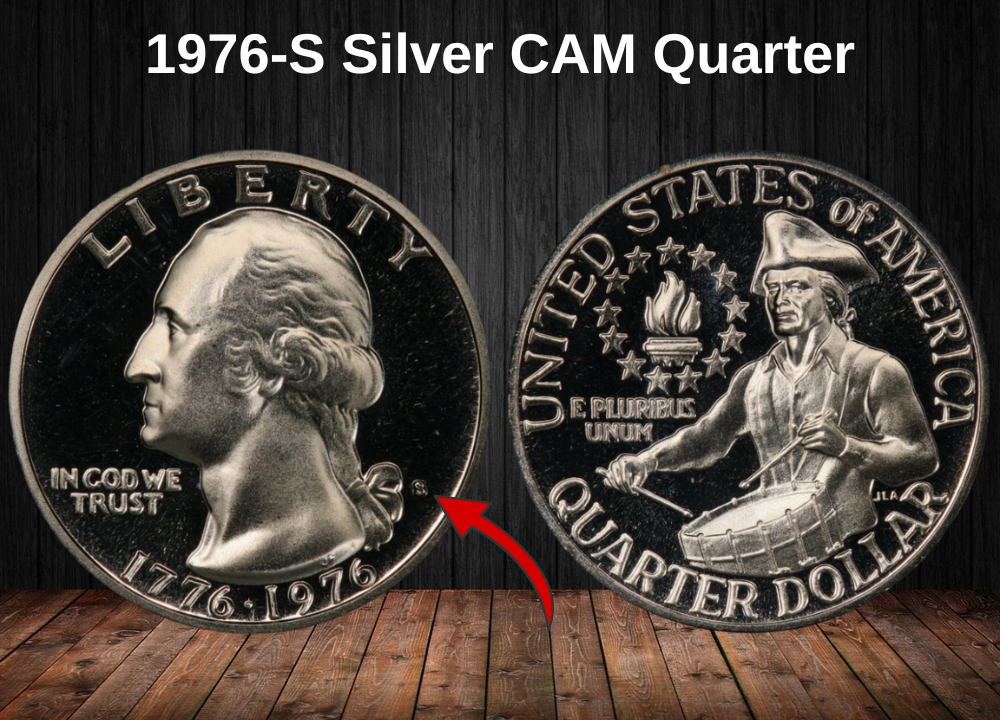
The 1976-S Silver Cameo (CAM) Bicentennial quarter offers collectors the best of both worlds: a 40% silver composition combined with the elegance of a cameo finish. This moderate frosted contrast against reflective proof fields enhances the coin’s visual presence, making it far more appealing than standard silver proofs.
As an entry point into silver Bicentennial collecting, these quarters provide both intrinsic bullion value and a numismatic premium. The silver content itself serves as a hedge against inflation, while the cameo designation adds collectible desirability.
With unknown mintage figures, Silver CAM proofs are scarcer than their clad counterparts, appealing to collectors and investors alike who seek precious metal content with enhanced eye appeal. This dual character—part bullion, part artistry—makes the 1976-S Silver CAM quarter especially attractive for those looking beyond simple silver value.
1976-S Silver CAM Quarter Price / Grade Chart
Latest Auction Records – Updated September 2, 2025
| Date | Auction House | Grade | Price Realized |
|---|---|---|---|
| 12/22 | DL | PR69 | $26 |
| 07/14 | GC | PR67 | $22 |
| 07/14 | GC | PR68 | $10 |
| 12/13 | GC | PR68 | $10 |
| 04/13 | GC | PR69 | $45 |
| 04/13 | GC | PR67 | $10 |
| 12/12 | HA | PR69 | $47 |
| 12/12 | GC | PR68 | $12 |
| 01/12 | GC | PR69 | $19 |
| 10/09 | DL | PR68 | $17 |
Note: PR69 Silver CAMs consistently bring premiums, while PR67–PR68 remain affordable entry points for silver proof collectors.
Market Activity – 1976-S Silver CAM Quarter
Auction data reflects steady demand for this hybrid variety. While prices remain modest compared to Deep Cameo examples, the combination of silver bullion value and cameo contrast makes them especially appealing to long-term collectors and investors.
The 1976-S Silver CAM quarter stands out as a dual-appeal collectible: tangible precious metal plus numismatic artistry—an ideal choice for those seeking value stability with added eye appeal.
1976-S Silver DCAM Quarter Value
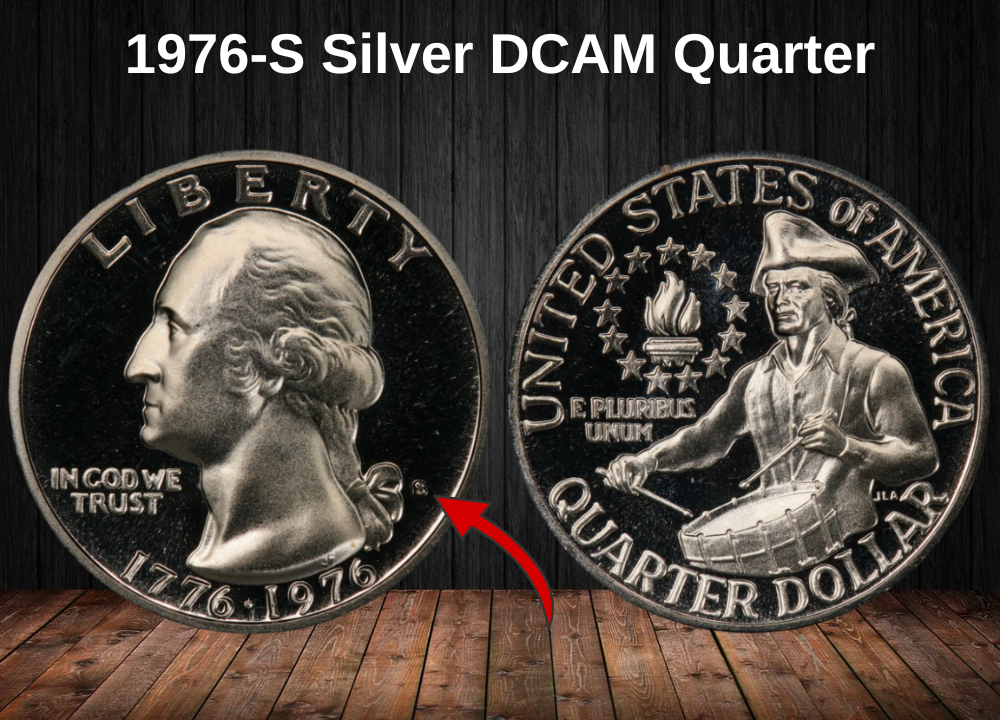
The 1976-S Silver Deep Cameo (DCAM) Bicentennial quarter represents the pinnacle of Bicentennial coinage. Struck in 40% silver, it combines intrinsic metal value with the most dramatic proof finish available.
Its heavily frosted devices stand out in bold contrast against deeply mirrored fields, producing the classic black-and-white cameo effect. This striking presentation brings the Drummer Boy reverse to life with unmatched clarity and depth.
For collectors, the Silver DCAM quarter embodies a coveted trifecta of desirability:
- Precious metal composition for bullion security,
- Exceptional proof striking quality, and
- Unparalleled eye appeal that sets it apart from every other Bicentennial issue.
These qualities make the 1976-S Silver DCAM not just a collectible, but a premium investment-grade coin sought by advanced numismatists.
1976-S Silver DCAM Quarter Price / Grade Chart
Latest Auction Records – Updated September 2, 2025
| Date | Auction House | Grade | Price Realized |
|---|---|---|---|
| 02/25 | SB | PR70 | $125 |
| 08/23 | HA | PR70 | $169 |
| 07/23 | HA | PR70 | $154 |
| 05/23 | HA | PR70 | $169 |
| 11/22 | HA | PR70 | $170 |
| 06/22 | DL | PR69 | $40 |
| 04/19 | DL | PR69 | $28 |
| 11/18 | DL | PR69 | $25 |
| 05/17 | HA | PR69 | $37 |
| 03/16 | DL | PR69 | $35 |
Note: Certified PR70 DCAMs consistently realize the strongest premiums, while PR69 examples remain attractive for collectors seeking affordability with top-tier eye appeal.
Market Activity – 1976-S Silver DCAM Quarter
Auction records confirm robust demand for this premium proof variety. With its blend of silver bullion value and numismatic excellence, the 1976-S Silver DCAM quarter continues to hold its place as the ultimate Bicentennial issue.
Collectors who acquire this variety secure not only a piece of America’s 200th birthday celebration but also one of the finest examples of modern U.S. proof coinage.
Rare 1976 Quarter Error List
1. 1976-D Double Die Obverse (DDO) Quarter Value
FS-101 and FS-102 Varieties
Among all Bicentennial quarter errors, the 1976-D Double Die Obverse (DDO) varieties rank as the most coveted by collectors. These dramatic hubbing mistakes occurred when dies were impressed twice at slightly different angles, leaving visible doubling in key design elements.
- FS-101 → Doubling most noticeable on “LIBERTY” and the dual date “1776–1976.”
- FS-102 → Strong doubling across “IN GOD WE TRUST” and on Washington’s profile details.
Both varieties stand out clearly to the naked eye once you know where to look, making them highly collectible and excellent targets for cherry-picking in dealer inventory or even circulation finds.
High-grade examples have achieved thousands of dollars at auction, with FS-101 appearing somewhat more often than the scarcer FS-102, which commands a stronger premium.
2. 1976 Bicentennial Quarter – Overstruck (Double Struck) Error
One of the most dramatic and desirable Bicentennial quarter errors is the Overstruck, or Double Struck, variety. This error occurs when a coin is struck more than once by the dies, creating overlapping images, distorted lettering, or even partially rotated secondary impressions.
Because each double strike is unique, no two error coins are exactly the same—giving each piece a “one-of-a-kind” character that fascinates collectors.
These errors are exceedingly rare and rarely surface in the marketplace. When they do, they command serious premiums. In fact, the record price for a 1976 Bicentennial double struck quarter reached $12,000 at auction in 2021, making it one of the highest-valued error quarters of the series.
3. 1976-D Bicentennial Quarter – Die Cap / Struck Through Error
Among the rarest and most coveted Bicentennial quarter errors is the Die Cap / Struck Through Planchet variety, found on certain 1976-D Washington quarters.
This error occurs when a blank planchet enters the coin press before the previously struck coin is ejected. As a result, the upper coin receives a sharp, distorted impression on one side, while the lower coin develops a “cap-like” deformation as the die continues to strike through it.
The effect produces a highly unusual appearance that makes these coins instantly recognizable and highly collectible.
Collector Value
- Entry-level pieces typically sell for several hundred dollars, depending on the severity of the error.
- The most dramatic and well-preserved examples can bring thousands. In fact, one specimen reached $2,880 at auction, setting a record for this error type.
Collector Insight
- Visual Impact → Each example is unique, with irregular shapes and dramatic impressions.
- Rarity → Far less common than doubled dies or filled mintmarks.
- Market Demand → Consistently strong, as die cap errors appeal to both error specialists and mainstream Bicentennial collectors.
The 1976-D Die Cap quarter is a true trophy error, representing the unpredictable artistry of the minting process and offering collectors a chance to own a piece that is literally one-of-a-kind.
4. 1976 Bicentennial Quarter – Struck-Through Error
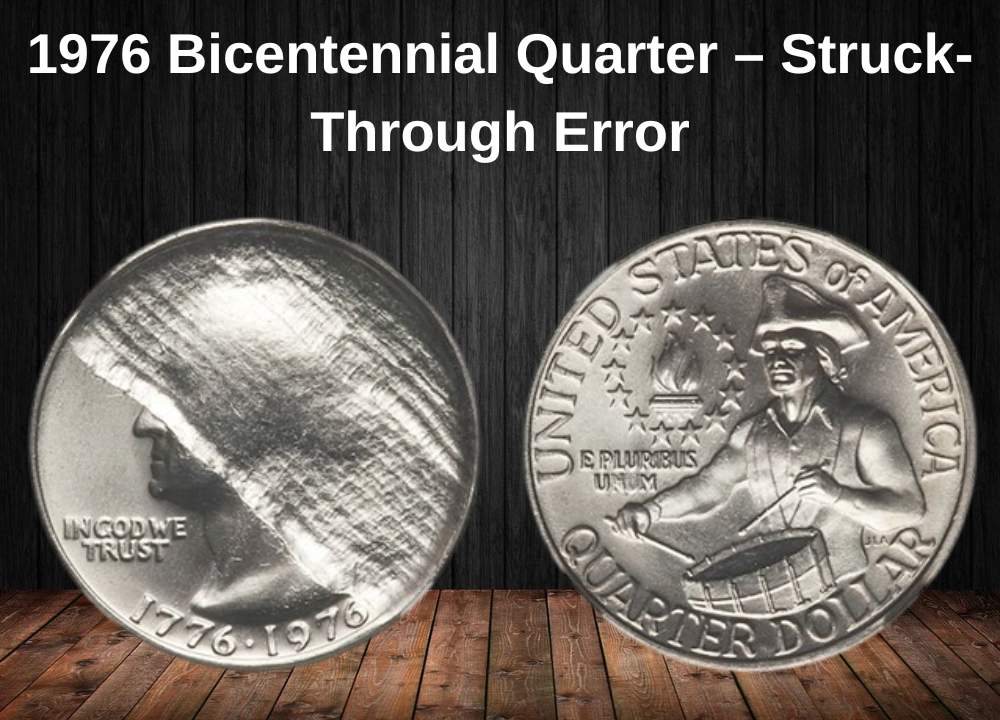
Another fascinating minting anomaly from the Bicentennial series is the Struck-Through Error. This occurs when a foreign object—such as a piece of cloth, wire, or even grease—comes between the die and the planchet during striking.
- In the most dramatic cases, a cloth impression leaves a textured surface on the coin, instantly visible and highly collectible.
- More subtle examples happen when a die clogged with grease weakens the design. On 1976 quarters, this often appears on the Colonial Drummer reverse, where fine details fade, producing an indistinct or blurry image detectable mostly by trained eyes.
Collector Value
- Typical struck-through Bicentennial quarters can sell for several hundred dollars, depending on severity and visibility of the error.
- The most valuable specimen to date was a MS66 struck-through example, which realized $881.25 at auction.
Collector Insight
- Visual Variety → No two struck-through errors are identical, giving each coin unique character.
- Range of Impact → From light grease strikes requiring magnification, to bold cloth impressions easily spotted at first glance.
- Market Appeal → Affordable compared to rarer errors like overstrikes, yet still highly sought after for their dramatic minting story.
The 1976 Struck-Through Bicentennial quarter exemplifies the unpredictability of minting and provides collectors with an error type that is both accessible and visually intriguing.
5. 1976 Bicentennial Quarter – Off-Center Obverse Error

One of the most visually striking errors of the Bicentennial series is the Off-Center Obverse strike. This occurs when the planchet is improperly aligned in the press, causing the design to be struck partially outside its intended borders.
The degree of misalignment varies:
- Minor Off-Center (3%–5%) → Common and less valuable.
- Moderate Off-Center (10%–15%) → More desirable, bringing stronger premiums.
- Major Off-Center (50%+) → The most collectible, especially when the date “1776–1976” remains visible.
Collector Value
- Typical off-center Bicentennial quarters can fetch several hundred dollars, depending on alignment and grade.
- Premium specimens—50% to 55% off-center with a full date—are considered the most desirable.
- The rarest combination is an Off-Center strike with a Filled “D” mintmark, which can command prices of up to $1,500 at auction.
Collector Insight
- Eye Appeal → Off-center errors are immediately noticeable, making them conversation pieces in any collection.
- Desirability → The greater the misalignment (while retaining a visible date), the higher the value.
- Rarity → Dramatic examples from 1976 remain scarce, with the dual-date design adding historical charm.
The 1976 Off-Center Bicentennial quarter is a favorite among error enthusiasts, offering both visual drama and collectible prestige.
6. 1976 Bicentennial Quarter – Die Crack Error
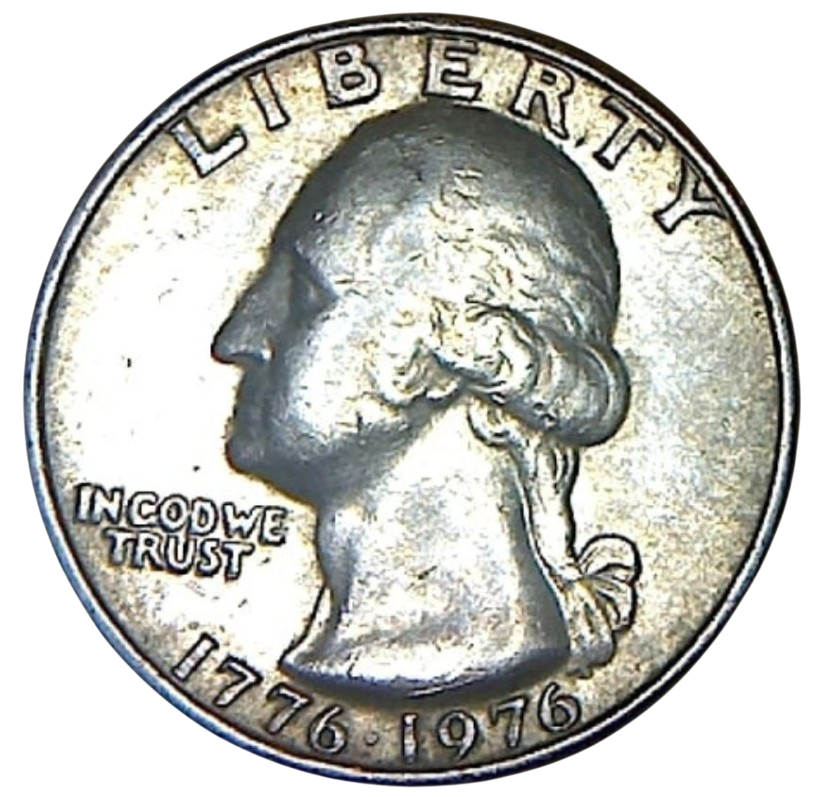
Among Bicentennial errors, one of the most frequently encountered is the Die Crack variety. This occurs when a worn or damaged die develops a fracture, which is then transferred as a raised line or ridge onto the coin’s surface during striking.
These cracks can appear in different areas of the design—along Washington’s profile, through the drummer boy, across lettering, or near the dual date. Because of their bold raised lines, they are easily recognizable even by non-experts, making them one of the most approachable error types for new collectors.
Collector Value
- Common die cracks are affordable and often collected as curiosities.
- More dramatic or well-placed cracks (for example, cutting through Washington’s eye, or across the drummer boy) are far scarcer and command premiums.
- Values vary widely: from only a few dollars for minor cracks, to several hundred dollars for dramatic, visually striking examples.
Collector Insight
- Accessibility → A perfect entry-level error coin, since even casual collectors can spot them easily.
- Variety → Each die crack is unique, giving these coins strong “one-of-a-kind” appeal.
- Market Demand → While common, dramatic cracks in desirable locations remain sought-after.
The 1976 Die Crack Bicentennial quarter may not always reach the record-setting prices of rarer errors, but it offers collectors a unique, affordable, and visually distinctive piece of minting history.
Top 10 Most Valuable 1976 Quarters
| Rank | Variety / Mintmark | Grade | Auction Price | Auction Year |
|---|---|---|---|---|
| 1 | 1976-S Silver Proof | MS69 | $19,200 | 2019 |
| 2 | 1976-D Double Die Obverse (FS-101) | MS66 | $8,400 | 2023 |
| 3 | 1976-D Regular Strike | MS68 | $6,463 | 2017 |
| 4 | 1976-D Regular Strike | MS68 | $5,170 | 2018 |
| 5 | 1976-S Silver Proof (DCAM) | MS69 | $6,600 | 2021 |
| 6 | 1976-D Double Die Obverse (FS-101) | MS65 | $1,920 | 2024 |
| 7 | 1976-D Double Die Obverse (FS-101) | MS64 | $2,520 | 2024 |
| 8 | 1976-D Double Die Obverse (FS-101) | MS63 | $1,680 | 2024 |
| 9 | 1976-D Error (Off-Center + Filled D) | MS63 | $1,320 | 2024 |
| 10 | 1976-D Double Die Obverse (FS-101) | MS53 | $518 | 2023 |
Where to Sell Your Quarter Coin?
Now that you know the value of your quarter, the next step is deciding where to sell it. There are several trusted options—both online and in person—that can help you get the best price depending on your coin’s rarity and condition.
To see the full list of recommended places, along with their advantages and disadvantages, check our complete guide on where to sell your quarter coins.
FAQ About The 1976 Quarter
1. Why is the 1976 Quarter considered special compared to other Washington quarters?
The 1976 Quarter was struck to celebrate the U.S. Bicentennial, marking 200 years since independence. Unlike regular Washington quarters, it features a unique reverse design with a colonial drummer and torch surrounded by 13 stars, making it a one-year commemorative issue.
2. What types of 1976 Quarters exist, and how do they differ?
There are three main types: clad copper-nickel quarters made for circulation, 40% silver quarters sold in special sets, and proof strikes with extra detail. Collectors often distinguish between these because the silver and proof versions command higher premiums.
3. Which errors or varieties of the 1976 Quarter are the most valuable?
Some of the most sought-after errors include double die obverses, off-center strikes, and coins struck on the wrong planchet. The famous 1976-D Doubled Die Obverse (FS-101) is among the most valuable, reaching thousands of dollars depending on condition.
4. How does coin grading affect the price of a 1976 Quarter?
Grading plays a crucial role. A circulated coin might be worth only face value, but the same variety in Mint State (MS65 or higher) can sell for hundreds or even thousands. High-grade proof and silver quarters also see exponential increases in value when graded PR69 or MS68+.
5. Are 1976 Quarters likely to increase in value in the future?
Yes—especially rare errors and high-grade examples. While common circulated coins may stay near face value, the Bicentennial series is historically significant. As more collectors seek premium specimens and as pristine coins become harder to find, prices are expected to trend upward over time.

